Friedrich YM18N34, SS12N10, SS12N30, SL36N30, EL36N35 User Manual
...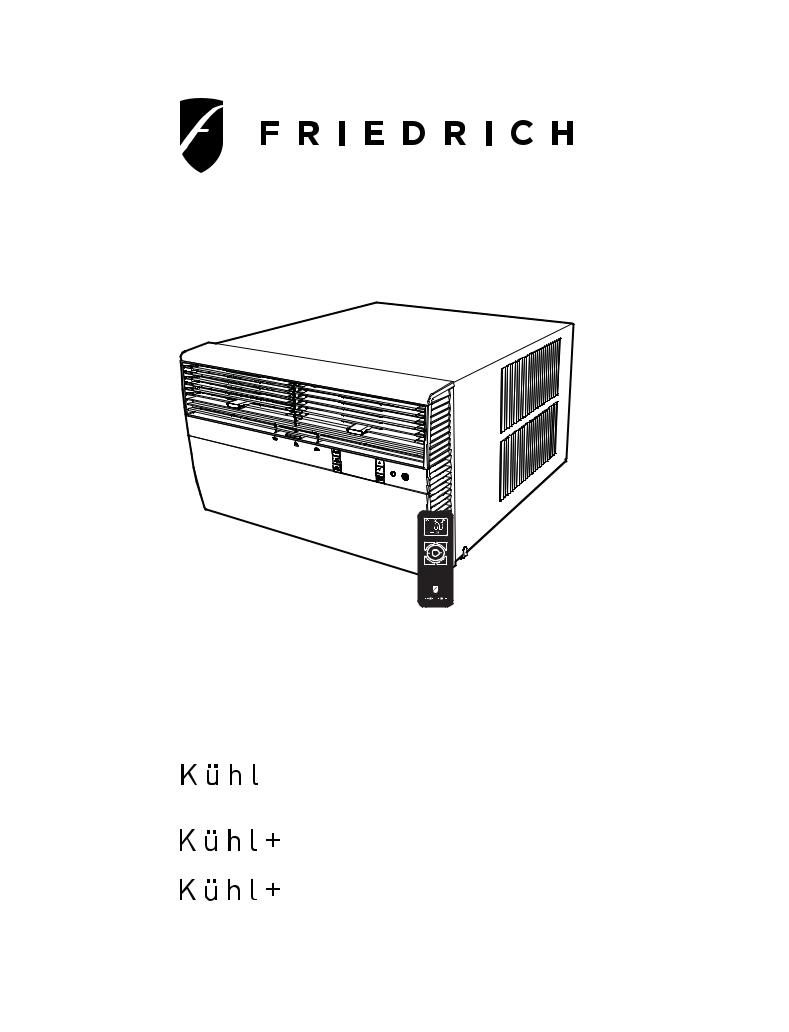
2012 Service/PartsServiceManualnu
Room Air Conditioners
|
C F |
SYSTEM |
FAN MODE |
POWER |
|
FAN SPEED |
SCHEDULE |
Standard Chassis Models
|
Cool Only |
|
1115--Volt: SS08N10*,08M10, SS10M10,SS10N10*,SS12M10,SS12N10*,4M10SS14N10*, SM15N10* |
|
208-230- --Volt: SS12N30*,12M30, SS15M30,SS15N30*,SM18M30,SM18N30*,SM21M30SM21N30* |
Cool |
SM24N30*,SL22N30*, SL24N30*, SL28N30*, SL36N30* |
|
|
|
CoololwithElectric Heat |
|
208208-230- --Volt: ES12N33*, ES15N33*, EM18N34*, EM24N34*, EL36N35* |
Electric Heat |
HeatPumpwithElectric Heat |
|
|
|
208208-230- --Volt: YS12N33*, YM18N34*, YL24N35* |
Heat Pump |
Heat Pump |
|
|
|
1115--Volt: YS10N10* |
|
|
Kuhl-Serv/PartsMan (9-12) |
*Last character may vary |
Table Of Contents |
|
Important Safety Information ..................................................................................................................................... |
2-4 |
Introduction ................................................................................................................................................................... |
5 |
Model and Serial Number Location .............................................................................................................................. |
5 |
Unit Identification .......................................................................................................................................................... |
6 |
Performance Data and Specifications .......................................................................................................................... |
7 |
Installation Information/Sleeve Dimensions/Circuit Rating ........................................................................................... |
8 |
Electrical Data ............................................................................................................................................................... |
9 |
Before Operating the Unit ............................................................................................................................................ |
10 |
Kuhl Control Options .................................................................................................................................................... |
11 |
Control Panel and Display Identification ...................................................................................................................... |
12 |
Control Panel Operation Instructions ...................................................................................................................... |
13-19 |
Remote Control Operation ...................................................................................................................................... |
20-21 |
Unit Operation ............................................................................................................................................................ |
22 |
Electronic Control Sequence of Operation ............................................................................................................ |
23-27 |
Fan Operation ............................................................................................................................................................. |
28 |
Removing the Front Cover and Unit Chassis ................................................................................................................ |
29 |
Replacing the ID Coil Thermistor ................................................................................................................................ |
30 |
Replacing the Control Board ....................................................................................................................................... |
30 |
Airflow Selection and Adjustment ............................................................................................................................... |
31 |
Components Testing .............................................................................................................................................. |
32-33 |
Testing the User Interface and Control Board ........................................................................................................... |
34 |
. |
. |
Refrigeration Sequence of Operation .......................................................................................................................... |
35 |
R410A Sealed System Repair Considerations ........................................................................................................... |
36 |
Sealed Refrigeration System Repairs .................................................................................................................... |
37-40 |
Hermetics Components Check ................................................................................................................................... |
41 |
Reversing Valve Description/Operation ...................................................................................................................... |
42 |
Testing the Coil ........................................................................................................................................................... |
43 |
Checking the Reversing Valve ............................................................................................................................... |
43-44 |
Compressor Checks .............................................................................................................................................. |
45-46 |
Compressor Replacement ..................................................................................................................................... |
47-48 |
Routine Maintenance ............................................................................................................................................. |
49-52 |
Service and Assistance/Avalaible Accessories .......................................................................................................... |
53 |
How to Check and Erase the Diagnostic Codes ........................................................................................................... |
54 |
Error Codes and Alarm Status .................................................................................................................................... |
55 |
Test Mode ................................................................................................................................................................... |
56 |
Thermistors' Resistance Values .................................................................................................................................. |
57 |
Performance Test Data Sheet ..................................................................................................................................... |
58 |
Troubleshooting ..................................................................................................................................................... |
59-68 |
ElectronicControlBoardComponentsIdentification&ThermistorVoltage................................................................... |
69 |
Electronic Control Configuration Instructions .............................................................................................................. |
70 |
Wiring Diagrams .................................................................................................................................................... |
71-79 |
Remote Control Replacement Instructions ........................................................................................................... |
80-81 |
User Interface Service Kit ........................................................................................................................................... |
82 |
Parts Section ......................................................................................................................................................... |
83-90 |
Addendum 1 ............................................................................................................................................................... |
91 |
Warranty ...................................................................................................................................................................... |
92 |
Authorized Parts Depots .............................................................................................................................................. |
93 |
Technical Support Contact Information......................................................................................................................... |
93 |
1
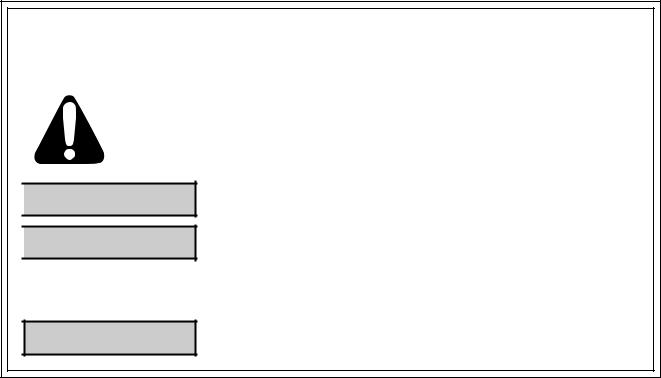
IMPORTANT SAFETY INFORMATION
The information contained in this manual is intended for use by a qualified service technician who is familiar with the safety procedures required for installation and repair, and who is equipped with the proper tools and test instruments required to service this product.
Installation or repairs made by unqualified persons can result in subjecting the unqualified person making such repairs as well as the persons being served by the equipment to hazards resulting in injury or electrical shock which can be serious or even fatal.
Safety warnings have been placed throughout this manual to alert you to potential hazards that may be encountered. If you install or perform service on equipment, it is your responsibility to read and obey these warnings to guard against any bodily injury or property damage which may result to you or others.
Your safety and the safety of others are very important.
We have provided many important safety messages in this manual and on your appliance. Always read and obey all safety messages.
This is a Safety Alert symbol.
This symbol alerts you to potential hazards that can kill or hurt you and others.
All safety messages will follow the safety alert symbol with the word “WARNING” or “CAUTION”. These words mean:

 WARNING
WARNING

 CAUTION
CAUTION
You can be killed or seriously injured if you do not follow instructions.
You can receive minor or moderate injury if you do not follow instructions.
All safety messages will tell you what the potential hazard is, tell you how to reduce the chance of injury, and tell you what will happen if the instructions are not followed.
A message to alert you of potential property damage will have the NOTICE word “NOTICE”. Potential property damage can occur if instructions
are not followed.
PERSONAL INJURY OR DEATH HAZARDS
ELECTRICAL HAZARDS:
•Unplug and/or disconnect all electrical power to the unit before performing inspections, maintenance, or service.
•Make sure to follow proper lockout/tag out procedures.
•Always work in the company of a qualified assistant if possible.
•Capacitors, even when disconnected from the electrical power source, retain an electrical charge potential capable of causing electric shock or electrocution.
•Handle, discharge, and test capacitors according to safe, established, standards, and approved procedures.
•Extreme care, proper judgment, and safety procedures must be exercised if it becomes necessary to test or troubleshoot equipment with the power on to the unit.
2
•Do not spray or pour water on the return air grille, discharge air grille, evaporator coil, control panel, and sleeve on the room side of the air conditioning unit while cleaning.
•Electrical component malfunction caused by water could result in electric shock or other electrically unsafe conditions when the power is restored and the unit is turned on, even after the exterior is dry.
•Never operate the A/C unit with wet hands.
•Use air conditioner on a single dedicated circuit within the specified amperage rating.
•Use on a properly grounded outlet only.
•Do not remove ground prong of plug.
•Do not cut or modify the power supply cord.
•Do not use extension cords with the unit.
•Follow all safety precautions and use proper and adequate protective safety aids such as: gloves, goggles, clothing, adequately insulated tools, and testing equipment etc.
•Failure to follow proper safety procedures and/or these warnings can result in serious injury or death.
REFRIGERATION SYSTEM REPAIR HAZARDS:
•Use approved standard refrigerant recovering procedures and equipment to relieve pressure before opening system for repair.
•Do not allow liquid refrigerant to contact skin. Direct contact with liquid refrigerant can result in minor to moderate injury.
•Be extremely careful when using an oxy-acetylene torch. Direct contact with the torch’s flame or hot surfaces can cause serious burns.
•Make sure to protect personal and surrounding property with fire proof materials.
•Have a fire extinguisher at hand while using a torch.
•Provide adequate ventilation to vent off toxic fumes, and work with a qualified assistant whenever possible.
•Always use a pressure regulator when using dry nitrogen to test the sealed refrigeration system for leaks, flushing etc.
•Make sure to follow all safety precautions and to use proper protective safety aids such as: gloves, safety glasses, clothing etc.
•Failure to follow proper safety procedures and/or these warnings can result in serious injury or death.
MECHANICAL HAZARDS:
•Extreme care, proper judgment and all safety procedures must be followed when testing, troubleshooting, handling, or working around unit with moving and/or rotating parts.
•Be careful when, handling and working around exposed edges and corners of the sleeve, chassis, and other unit components especially the sharp fins of the indoor and outdoor coils.
•Use proper and adequate protective aids such as: gloves, clothing, safety glasses etc.
•Failure to follow proper safety procedures and/or these warnings can result in serious injury or death.
3
PROPERTY DAMAGE HAZARDS
FIRE DAMAGE HAZARDS:
•Read the Installation/Operation Manual for the air conditioning unit prior to operating.
•Use air conditioner on a single dedicated circuit within the specified amperage rating.
•Connect to a properly grounded outlet only.
•Do not remove ground prong of plug.
•Do not cut or modify the power supply cord.
•Do not use extension cords with the unit.
•Be extremely careful when using acetylene torch and protect surrounding property.
•Failure to follow these instructions can result in fire and minor to serious property damage.
WATER DAMAGE HAZARDS:
•Improper installation, maintenance or servicing of the air conditioner unit can result in water damage to personal items or property.
•Insure that the unit has a sufficient pitch to the outside to allow water to drain from the unit.
•Do not drill holes in the bottom of the drain pan or the underside of the unit.
•Failure to follow these instructions can result in damage to the unit and/or minor to serious property damage.
4
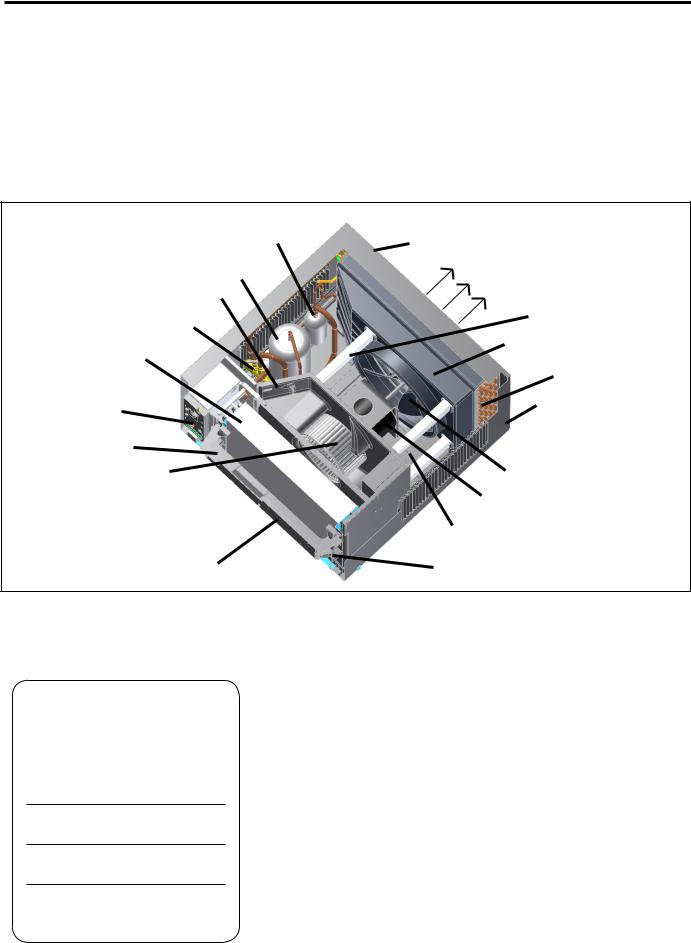
INTRODUCTION
This service manual is designed to be used in conjunction with the installation and operation manuals provided with each air conditioning system.
This service manual was written to assist the professional RAC (Room Air Conditioner) service technician to quickly and accurately diagnose and repair malfunctions.
This manual will deal with subjects in a general nature.
COMPONENTS IDENTIFICATION
Accumulator |
Outdoor Grille |
|||
Compressor |
Discharge Air |
|||
Fresh Air Vent |
|
Shroud brace |
||
Reversing Valve |
|
|||
|
Condense/Fan Shroud |
|||
Evaporator Coil |
|
|||
|
|
|
||
Electronic Control |
|
|
Condenser Coil |
|
|
|
Sleeve |
||
Board |
|
|
||
Control Key Pad |
|
|
Air Intake Vents |
|
|
|
|||
Support Bar |
|
|
|
|
Blower Wheel |
|
Fan Blade |
||
Air Intake From |
|
Fan/Blower Motor |
||
Sides and Bottom |
Base Pan |
|||
|
||||
Control Key Pad |
Chassis Pull |
|||
(User Interface) |
||||
Out Handle |
||||
|
||||
IMPORTANT: It will be necessary for you to accurately identify the unit you are servicing, so you can be certain of a proper diagnosis and repair (See Unit Identification code on page 6).
MODEL AND SERIAL NUMBER LOCATION
Register your air conditioner
Model information can be found on the name plate behind the front cover.
For your future convenience, record the model information here.
MODEL NUMBER
SERIAL NUMBER
PURCHASE DATE
5
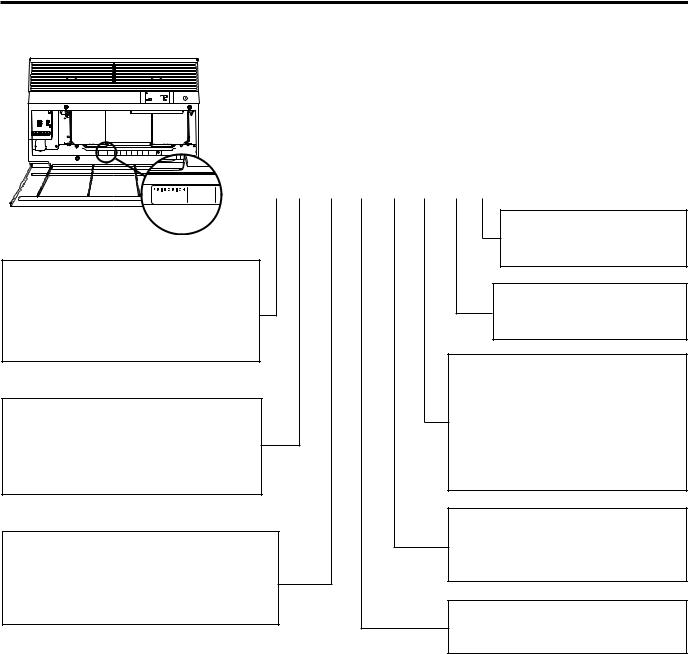
UNIT IDENTIFICATION
Model Number Code
S S 08 M 1 0 B A
|
MODEL NUMBER |
AIR CONDITIONING CO. |
YS10M10A |
SAN ANTONIO, TEXAS |
SERIAL NUMBER |
ASSEMBLED IN MEXICO |
LICY00008 |
1st Digit – Function
S = Straight Cool, Value Series
Y = Heat Pump
E = Electric Heat
2nd Digit
S = Small Chassis M = Medium Chassis L = Large Chassis
3rd and 4th Digit - Approximate BTU/HR in 1000s (Cooling)
Heating BTU/Hr capacity listed in the
Specification/Performance Data Section
9th Digit, Engineering Suffix
Major modification Subject to change
8th Digit, Marketing Suffix
Indicates modification Subject to change
7th Digit – Options
0 = Straight Cool &
Heat Pump Models
3 = 3 KW Heat Strip, Nominal
4 = 4 KW Heat Strip, Nominal
5 = 5 KW Heat Strip, Nominal
6th Digit – Voltage
1 = 115 Volts
3 = 230-208 Volts
5th Digit
Alphabetical Modifier
RAC Serial Number Identification Guide
Serial Number |
|
A |
B |
A |
R |
00001 |
|
Decade Manufactured |
|
|
|
|
|
||
L=0 |
C=3 |
F=6 |
J=9 |
|
|
|
Production Run Number |
A=1 |
D=4 |
G=7 |
|
|
|
|
|
B=2 |
E=5 |
H=8 |
|
|
|
|
Product Line |
|
|
|
|
|
|||
Year Manufactured |
|
|
|
|
|||
A=1 |
D=4 |
G=7 |
K=0 |
|
|
|
R = RAC |
B=2 |
E=5 |
H=8 |
|
|
|
|
|
C=3 |
F=6 |
J=9 |
|
|
|
|
|
|
|
|
|
|
|
||
Month Manufactured |
|
|
|
|
|
||
A=Jan D=Apr G=Jul K=Oct |
|
|
|
|
|||
B=Feb E=May H=Aug L=Nov |
|
|
|
|
|||
C=Mar F=Jun J=Sept M=Dec |
|
|
|
|
|||
|
|
|
|
|
|
|
|
6
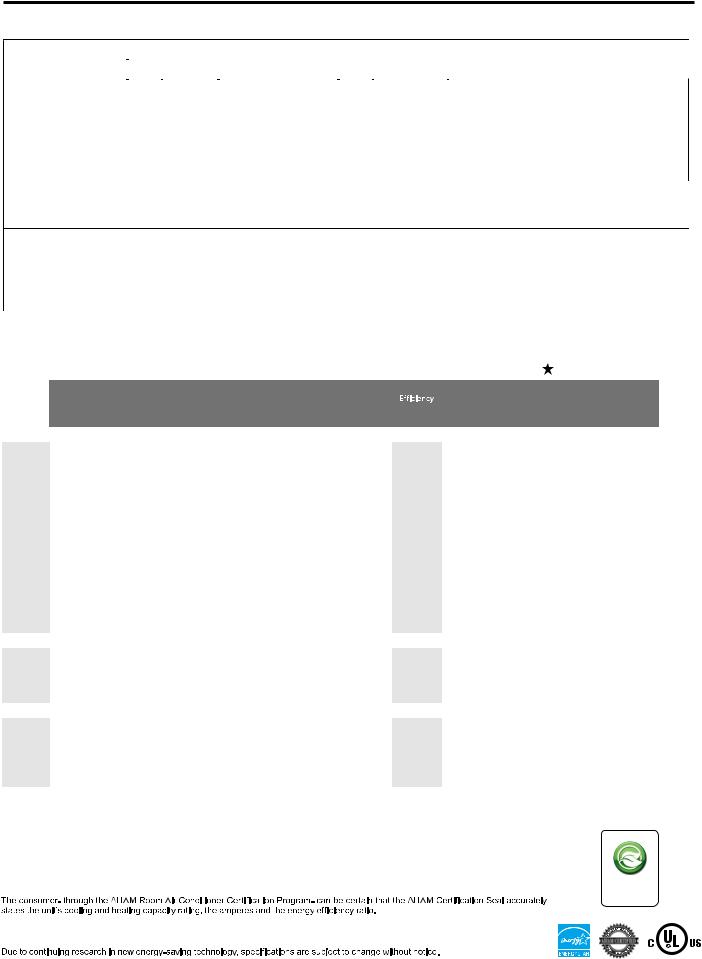
REFRIGERATION SYSTEM PERFORMANCE DATA
COOLING |
EVAP. AIR TEMP. DEG. |
CONDENSER |
Discharge |
Suction |
|
Sub- |
OPERATING |
ELECTRICAL RATINGS |
R-410A |
|
BREAKER |
||||
F |
|
Super Heat |
PRESSURES |
REF. |
Voltage |
FUSE |
|||||||||
PERFORMANCE |
|
Temp. |
|
|
Amps |
Amps |
Locked Rotor |
Charge in |
60 Hertz |
||||||
DATA* |
Discharge Air |
TEMP DEG. F |
Temp |
Temp |
|
Cooling |
Suction |
Discharge |
|
||||||
Drop F. |
|
|
|
|
|
Cool |
Heat |
Amps |
OZ. |
|
Amps |
||||
SS08N10-A |
54 |
26 |
114 |
153 |
65 |
7 |
19 |
151 |
400 |
6.1 |
|
32.0 |
26.0 |
115 |
15 |
YS10N10-A |
59 |
21 |
115 |
155 |
67 |
12 |
14 |
147 |
395 |
7.8 |
7.6 |
50.0 |
26.5 |
115 |
15 |
SS10N10-A |
54 |
26 |
114 |
157 |
68 |
16 |
17 |
137 |
392 |
7.7 |
|
50.0 |
27.0 |
115 |
15 |
SS12N10-A |
56 |
24 |
119 |
170 |
60 |
14 |
25 |
135 |
423 |
10.0 |
|
55.0 |
30.0 |
115 |
15 |
SS14N10-A |
55 |
25 |
120 |
171 |
62 |
14 |
23 |
141 |
390 |
12.0 |
|
63.0 |
31.0 |
115 |
15 |
SS12N30-A |
47 |
33 |
114 |
155 |
58 |
10 |
18 |
134 |
393 |
4.8 |
|
30.0 |
31.5 |
230/208v |
15 |
ES12N33-A |
47 |
33 |
114 |
155 |
58 |
10 |
18 |
135 |
393 |
4.8 |
16.0 |
30.0 |
31.5 |
230/208v |
20 |
YS12N30-A |
61 |
19 |
118 |
169 |
69 |
18 |
21 |
137 |
413 |
5.2 |
5.6 |
26.0 |
32.0 |
230/208v |
20 |
SS15N30-A |
54 |
26 |
119 |
174 |
59 |
12 |
34 |
127 |
420 |
6.4 |
|
32.0 |
33.5 |
230/208v |
15 |
ES15N33-A |
54 |
26 |
119 |
174 |
59 |
12 |
34 |
127 |
420 |
6.4 |
16.0 |
32.0 |
33.5 |
230/208v |
20 |
SM15N10-A |
55 |
25 |
118 |
153 |
58 |
10 |
18 |
140 |
410 |
12.6 |
|
63.0 |
37.0 |
115 |
15 |
|
|||||||||||||||
SM18N30-A |
57 |
23 |
120 |
169 |
61 |
14 |
22 |
136 |
422 |
7.4 |
|
42.0 |
39.5 |
230/208v |
15 |
EM18N34-A |
57 |
23 |
120 |
169 |
61 |
14 |
22 |
136 |
422 |
7.4 |
19.5 |
42.0 |
39.5 |
230/208v |
30 |
YM18N34-A |
48 |
32 |
118 |
169 |
53 |
10 |
21 |
126 |
413 |
8.5 |
8.5 |
44.0 |
40.0 |
230/208v |
30 |
SM21N30-A |
60 |
20 |
123 |
175 |
65 |
10 |
20 |
130 |
448 |
9.4 |
|
46.0 |
40.0 |
230/208v |
15 |
SM24N30-A |
45 |
35 |
127 |
175 |
50 |
10 |
28 |
119 |
457 |
11.2 |
|
60.5 |
43.6 |
230/208v |
20 |
EM24N34-A |
45 |
35 |
127 |
175 |
50 |
10 |
28 |
119 |
457 |
11.2 |
19.5 |
60.5 |
43.5 |
230/208v |
30 |
YL24N35-A |
58 |
22 |
119 |
174 |
64 |
22 |
20 |
124 |
417 |
11.1 |
12.2 |
47.0 |
73.0 |
230/208v |
30 |
SL22N30-A |
54 |
26 |
119 |
159 |
59 |
10 |
20 |
139 |
409 |
9.4 |
|
48.0 |
57.0 |
230/208v |
15 |
SL24N30-A |
54 |
26 |
123 |
163 |
58 |
16 |
19 |
132 |
435 |
11.2 |
|
47.0 |
69.0 |
230/208v |
20 |
SL28N30-A |
54 |
26 |
122 |
173 |
60 |
11 |
26 |
139 |
445 |
12.7 |
|
60.0 |
70.5 |
230/208v |
20 |
SL36N30-A |
52 |
28 |
130 |
190 |
56 |
13 |
33 |
126 |
480 |
18.0 |
|
88.0 |
72.0 |
230/208v |
30 |
EL36N35-A |
52 |
28 |
130 |
190 |
56 |
13 |
33 |
126 |
480 |
18.0 |
24.0 |
88.0 |
72.0 |
230/208v |
30 |
*Rating Conditions: 80 degrees F, room air temp. & 50% relative humidity, with 95 degree F, outside air temp & 40% relative humidity, all systems use R-410A. Test done at highest unit fan speed.
|
SPECIFICATIONS |
|
|
|
|
|
|
|
|
ENERGY STAR® models |
||||||
|
|
|
|
|
|
|
|
|
Energy |
Estimated |
|
|
|
|
|
|
|
|
|
|
|
|
|
|
|
|
Yearly |
|
Moisture |
|
|
|
|
|
|
|
|
Volts |
Cooling |
Cooling |
Heating |
Heating |
Ratio |
Operating |
|
Removal - |
|
|
Net |
Ship |
|
MODEL |
Cooling Btu |
Heating Btu |
Rated |
Amps |
Watts |
Amps |
Watts |
EER |
Cost |
COP |
Pints/HR |
CFM |
Sleeve |
Wt |
Wt. |
|
|
|
|
|
|
|
|
|
|
|
|
|
|
|
|
|
|
Kühl ® |
|
|
|
|
|
|
|
|
|
|
|
|
|
|
|
|
|
|
|
|
|
|
|
|
|
|
|
|
|
|
|
|
* |
SS08N10 |
7900 |
- |
115 |
6.1 |
677 |
- |
- |
11.7 |
$54 |
- |
1.0 |
265 |
S |
99 |
121 |
* |
SS10N10 |
9500 |
- |
115 |
7.7 |
848 |
- |
- |
11.2 |
$67 |
- |
2.0 |
260 |
S |
106 |
136 |
* |
SS12N10 |
12000 |
- |
115 |
10.0 |
1111 |
- |
- |
10.8 |
$88 |
- |
3.0 |
300 |
S |
112 |
136 |
|
SS14N10 |
14000 |
- |
115 |
12.0 |
1444 |
- |
- |
9.7 |
$115 |
- |
3.5 |
325 |
S |
116 |
133 |
* |
SS12N30 |
11500/11200 |
- |
230/208 |
4.8/4.9 |
1055/1027 |
- |
- |
10.9/10.9 |
$84 |
- |
2.8 |
275 |
S |
112 |
134 |
|
SS15N30 |
14500/14300 |
- |
230/208 |
6.4/6.8 |
1480/1459 |
- |
- |
9.8/9.8 |
$112 |
- |
3.5 |
360 |
S |
116 |
136 |
* |
SM15N10 |
14800 |
- |
115 |
12.0 |
1358 |
- |
- |
10.9 |
$109 |
- |
3.5 |
360 |
M |
141 |
154 |
* |
SM18N30 |
17500/17200 |
- |
230/208 |
7.4/8.0 |
1635/1607 |
- |
- |
10.7/10.7 |
$131 |
- |
4.6 |
350 |
M |
140 |
158 |
* |
SM21N30 |
20500/20000 |
- |
230/208 |
9.4/10.3 |
2181/2128 |
- |
- |
9.4/9.4 |
$173 |
- |
6.0 |
425 |
M |
132 |
153 |
|
SM24N30 |
22300/22000 |
- |
230/208 |
11.2/11.9 |
2590/2550 |
- |
- |
8.6/8.6 |
$206 |
- |
10.0 |
390 |
M |
152 |
167 |
* |
SL22N30 |
21000/20500 |
- |
230/208 |
9.6/10.2 |
2188/2092 |
- |
- |
9.6/9.8 |
$174 |
- |
6.0 |
625 |
L |
191 |
212 |
* |
SL24N30 |
24000/23800 |
- |
230/208 |
11.2/12.0 |
2553/2532 |
- |
- |
9.4/9.4 |
$207 |
- |
7.0 |
640 |
L |
192 |
213 |
* |
SL28N30 |
27500/27000 |
- |
230/208 |
13.5/14.4 |
2926/2872 |
- |
- |
9.4/9.4 |
$229 |
- |
8.5 |
600 |
L |
193 |
214 |
|
SL36N30 |
36000/35700 |
- |
230/208 |
19.0/20.5 |
4235/4200 |
- |
- |
8.5/8.5 |
$338 |
- |
12.0 |
725 |
L |
212 |
227 |
|
Kühl ® + Heat Pump |
|
|
|
|
|
|
|
|
|
|
|
|
|
|
|
|
|
|
|
|
|
|
|
|
|
|
|
|
|
|
|
|
* |
YS10N10* |
9400 |
7500 |
115 |
7.8 |
855 |
7.6 |
743 |
11.0 |
$68 |
3.0 |
1.9 |
285 |
S |
109 |
131 |
* |
YS12N33 |
11500/11300 |
9400/9000 |
230/208 |
5.2/5.4 |
1095/1076 |
5.6/5.8 |
1132/1139 |
10.5/10.5 |
$87 |
2.4/2.3 |
3.0 |
265 |
S |
115 |
136 |
* |
YM18N34 |
18200/17800 |
17900/17700 |
230/208 |
8.5/8.9 |
1808/1788 |
8.5/8.7 |
1833/1761 |
9.9/9.9 |
$147 |
2.5/2.6 |
5.4 |
370 |
M |
141 |
152 |
* |
YL24N35 |
23500/23000 |
23500/23000 |
230/208 |
11.1/12.0 |
2500/2447 |
12.2/14.3 |
2610/2575 |
9.4/9.4 |
$199 |
2.6/2.6 |
7.0 |
600 |
L |
197 |
212 |
|
Kühl ® + Electric Heat |
|
|
|
|
|
|
|
|
|
|
|
|
|
|
|
|
|
|
|
|
|
|
|
|
|
|
|
|
|
|
|
|
|
ES12N33 |
11500/11200 |
10700/8900 |
230/208 |
4.8/4.9 |
1055/1027 |
16.0/14.7 |
3500/2900 |
10.9/10.9 |
$84 |
- |
2.8 |
275 |
S |
113 |
128 |
|
ES15N33 |
14500/14300 |
10700/8900 |
230/208 |
6.4/6.8 |
1480/1459 |
16.0/14.7 |
3500/2900 |
9.8/9.8 |
$112 |
- |
3.5 |
360 |
S |
117 |
133 |
|
EM18N34 |
17500/17200 |
13000/10600 |
230/208 |
7.4/8.0 |
2590/2550 |
19.5/17.0 |
4200/3500 |
8.6/8.6 |
$131 |
- |
4.6 |
350 |
M |
141 |
158 |
|
EM24N34 |
22300/22000 |
13000/10600 |
230/208 |
11.2/11.9 |
2590/2550 |
19.5/17.0 |
4200/3500 |
8.6/8.6 |
$207 |
- |
10.0 |
390 |
M |
153 |
166 |
|
EL36N35 |
36000/35700 |
17300/14300 |
230/208 |
19.0/20.5 |
4235/4200 |
24.0/22.4 |
5500/4650 |
8.5/8.5 |
$338 |
- |
12.0 |
725 |
L |
213 |
225 |
* Operates on 115 volt and is not equipped with supplemental heat. Will not provide heat at temperatures below 40°F. Friedrich room air conditioners are designed to operate in outdoor temperatures from 60° F to 115° F.
Kühl+ Heat Pump heating information (shown in red) indicates heat pump performance. Kühl+ and Chill+ Electric Heat heating information (shown in red) indicates electric heat strip performance. For Kühl+ Heat Pump electric heating performance refer to corresponding Kühl+ Electric Heat model.
As an ENERGY STAR® partner, Friedrich Air Conditioning Co. has determined that the selected ENERGY STAR® models meet the ENERGY STAR® 
R-410A
All models use environmentally friendly R-410A refrigerant.
Estimated yearly operating cost based on a 2007 national average electricity cost of 10.65 cents per kWh.
7 |
LISTED |
|
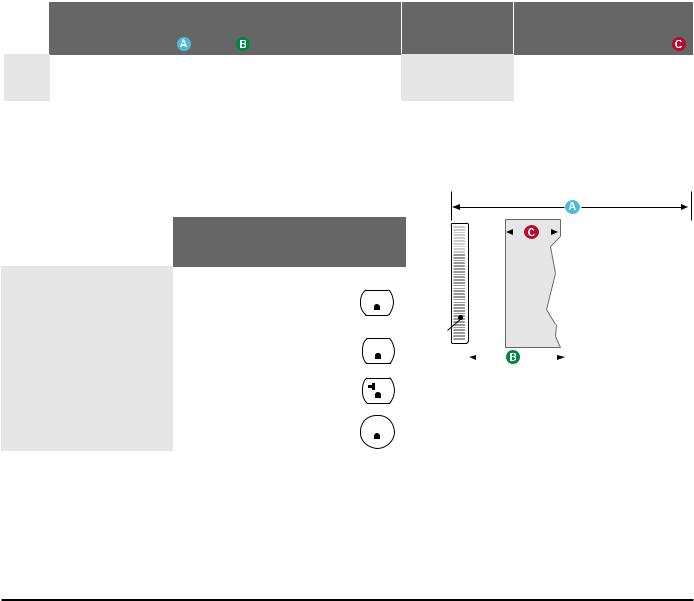
Installation Information / Sleeve Dimensions
|
|
|
Depth |
Shell Depth to |
|
|
|
|
Thru-the-wall Installation |
||
|
|
|
Minimum |
Minimum |
Window Width |
|
Finished Hole |
||||
|
|
|
with Front |
Louvers |
Extension |
Extension |
|
|
|
|
|
Sleeve |
|
|
|
|
|
|
|
|
|
||
Height |
Width |
|
|
Into Room* |
Outside* |
Minimum** |
Maximum |
Height |
Width |
Max. Depth |
|
S |
15 15/16" |
25 15/16" |
29" |
8 ¾" |
5 ¾” |
16 15/16” |
27 3/8" |
42" |
16 3/16” |
26 3/16” |
7 3/8" |
M |
17 15/16" |
25 15/16" |
29" |
8 ¾" |
5 ¾” |
16 15/16” |
27 3/8" |
42" |
18 3/16” |
26 3/16” |
7 3/8” |
L |
20 3/16" |
28" |
35 ½” |
16 ½" |
5 3/8” |
18 15/16” |
29 7/8” |
42" |
20 3/8" |
28 ¼" |
15 1/8” |
*Minimum extensions when mounted in a window.
**Minimum widths achieved using one side curtain assembly as opposed to both in a standard installation. NOTE: S,M and L sleeves may be installed in window with no side kits if properly installed.
Circuit Rating/ Breaker
|
Circuit Rating |
Plug |
Power Cord |
Wall Outlet |
|
|
|
|
|
|
|
|
|
|
|
|
|
|
|
|
|
|
|
|
|
|
|
|
|
|
|
|
|
|
|
|
|
||||||
|
|
|
|
|
|
|
|
|
|
|
|
|
|
|
|
|
|
|
|
|
|
|
|
|
|
|
|
|
|
|
|
|
|
||||||||||
|
|
|
|
|
|
|
|
|
|
|
|
|
|
|
|
|
|
|
|
|
|
|
|
|
|
|
|
|
|
|
|
|
|
||||||||||
Model |
Breaker or |
Face |
|
|
|
|
|
|
|
|
|
|
|
|
|
|
|
|
|
|
|
|
|
|
|
|
|
|
|
|
|
|
|
|
|
||||||||
|
|
|
|
|
|
|
|
|
|
|
|
|
|
|
|
|
|
|
|
|
|
|
|
|
|
|
|
|
|
|
|
|
|||||||||||
T-D Fuse |
(NEMA#) |
Length (ft.) |
Appearance |
|
|
|
|
|
|
|
|
|
|
|
|
|
|
|
|
|
|
|
|
|
|
|
|
|
|
|
|
|
|
|
|
|
|||||||
SS08N10, SS10N10, SS12N10 and |
125V - 15A |
5 - 15P |
6 |
|
|
|
|
|
|
|
|
|
|
|
|
|
|
|
|
|
|
|
|
|
|
|
|
|
|
|
|
|
|
|
|
|
|
|
|
|
|
|
|
|
|
|
|
|
|
|
|
|
|
|
|
|
|
|
|
|
|
|
|
|
|
|
|
|
|
|
|
|
|
|
|
|
|
|
|
|
|
|
|
||||
|
|
|
|
|
|
|
|
|
|
|
|
|
|
|
|
|
|
|
|
|
|
|
|
|
|
|
|
|
|
|
|
|
|
|
|
|
|
|
|
||||
SS14N10, SM15N10, YS10N10 |
|
|
|
|
|
|
|
|
|
|
|
|
|
|
|
|
|
|
|
|
|
|
|
|
|
|
|
|
|
|
|
|
|
|
|
|
|
|
|
|
|||
|
|
|
|
|
|
|
|
|
|
Front |
|
|
|
|
|
|
|
|
|
|
|
|
|
|
|
|
|
|
|
|
|
|
|
|
|
|
|
|
|
|
|
||
|
|
|
|
|
|
|
|
|
|
|
|
|
|
|
|
|
|
|
|
|
|
|
|
|
|
|
|
|
|
|
|
|
|
|
|
|
|
|
|
|
|
||
|
|
|
|
|
|
|
|
|
|
|
|
|
|
|
|
|
|
|
|
|
|
|
|
|
|
|
|
|
|
|
|
|
|
|
|
|
|
|
|
|
|
||
|
|
|
|
|
|
|
|
|
|
|
|
|
|
|
|
|
|
|
|
|
|
|
|
|
|
|
|
|
|
|
|
|
|
|
|
|
|
|
|
|
|
||
SS12N30, SS15N30, SM18N30 and |
250V - 15A |
6 - 15P |
4 |
|
|
|
|
|
|
|
|||||||||||||||||||||||||||||||||
|
|
|
|
|
|
|
|
|
|
|
|
|
|
|
|
|
|
|
|
|
|
|
|
|
|
|
|
|
|
|
|
|
|
|
|
|
|
|
|
||||
|
|
|
|
|
|
|
|
|
|
|
|
|
|
|
|
|
|
|
|
|
|
|
|
|
|
SIDE VIEW |
|||||||||||||||||
|
|
|
|
|
|
|
|
|
|
|
|
|
|
|
|
|
|
|
|
|
|
|
|
|
|
||||||||||||||||||
SM21N30, SL22N30 |
|
|
|
|
|
|
|
|
|
|
|
|
|
|
|
|
|
|
|
|
|
|
|
|
|
|
|||||||||||||||||
|
|
|
|
|
|
|
|
|
|
|
|
|
|
|
|
|
|
|
|
|
|
|
|
|
|
|
|
|
|||||||||||||||
|
|
|
|
|
|
|
|
|
|
|
|
|
|
|
|
|
|
|
|
|
|
|
|
|
|
|
|
|
|
|
|
|
|
|
|
|
|
|
|
|
|
|
|
|
|
|
|
|
|
|
|
|
|
|
|
|
|
|
|
|
|
|
|
|
|
|
|
|
|
|
|
|
|
|
|
|
|
|
|
|
|
|
|
|
|
|
|
SM24N30, SL24N30,SL28N30, |
250V - 20A |
6 - 20P |
4 |
|
|
|
|
|
|
|
|
|
|
|
|
|
|
|
|
|
|
|
|
|
|
|
|
|
|
|
|
|
|
|
|
|
|
|
|
|
|
|
|
|
|
|
|
|
|
|
|
|
|
|
|
|
|
|
|
|
|
|
|
|
|
|
|
|
|
|
|
|
|
|
|
|
|
|
|
|
|
|
|
||||
ES12N33, ES15N33, YS12N33 |
|
|
|
|
|
|
|
|
|
|
|
|
|
|
|
|
|
|
|
|
|
|
|
|
|
|
|
|
|
|
|
|
|
|
|
|
|
|
|
|
|||
|
|
|
|
|
|
|
|
|
|
|
|
|
|
|
|
|
|
|
|
|
|
|
|
|
|
|
|
|
|
|
|
|
|
|
|
|
|
|
|
|
|
|
|
|
|
|
|
|
|
|
|
|
|
|
|
|
|
|
|
|
|
|
|
|
|
|
|
|
|
|
|
|
|
|
|
|
|
|
|
|
|
|
|
|
|
|
|
SL36N30, EM18N34, EM24N34, |
250V - 30A |
6 - 30P |
4 |
|
|
|
|
|
|
|
|
|
|
|
|
|
|
|
|
|
|
|
|
|
|
|
|
|
|
|
|
|
|
|
|
|
|
|
|
|
|
|
|
|
|
|
|
|
|
|
|
|
|
|
|
|
|
|
|
|
|
|
|
|
|
|
|
|
|
|
|
|
|
|
|
|
|
|
|
|
|
|
|
||||
EL36N35, YM18N34 and YL24N35 |
|
|
|
|
|
|
|
|
|
|
|
|
|
|
|
|
|
|
|
|
|
|
|
|
|
|
|
|
|
|
|
|
|
|
|
|
|
|
|
|
|
|
|
|
|
|
|
|
|
|
|
|
|
|
|
|
|
|
|
|
|
|
|
|
|
|
|
|
|
|
|
|
|
|
|
|
|
|
|
|
|
|
|
|
|
|
|
For the best cooling performance and highest energy efficiency
Keep the filter clean
Make sure that your air conditioner is always in top performing condition by cleaning the filter regularly.
Provide good air flow
Make sure the airflow to and from the unit is clear. Your air conditioner puts the conditioned air out at the top of the unit, and takes in unconditioned air at the bottom. Airflow is critical to good operation. It is just as important on the outside of the building that the airflow around the unit exterior is not blocked.
Unit placement
If your air conditioner can be placed in a window or wall that is shaded by a tree or another building, the unit will operate even more efficiently. Using drapes or blinds on the sunny side of the dwelling will also add to your unit’s efficiency.
Insulation
Good insulation will be a big help in maintaining desirable comfort levels. Doors should have weather stripping. Be sure to caulk around doors and windows.
Proper installation of seal gasket
Make sure the seal gasket has been installed properly to minimize noise and improve efficiency. If the seal gasket has not been installed, please refer to the installation instructions.
8
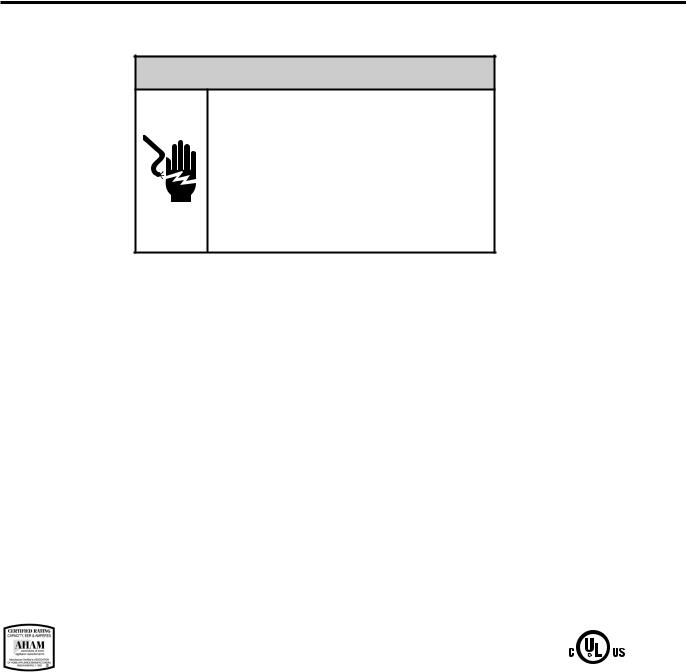
ELECTRICAL DATA
 WARNING
WARNING
ELECTRIC SHOCK HAZARD
Turn off electric power before service or installation.
All electrical connections and wiring MUST be installedbyaqualifiedelectricianandconformto the National Electrical Code and all local codes
which have jurisdiction.
Failure to do so can result in personal injury or death.
|
NOTICE |
|
|
FIRE HAZARD |
|
|
Not following the above WARNING could result in fire or |
|
|
electically unsafe conditions which could cause moderate |
|
|
or serious property damage. |
|
|
Read, understand and follow the above warning. |
|
|
|
|
Wire Size |
Use ONLY wiring size recommended for single outlet branch circuit. |
|
Fuse/Circuit Breaker |
Use ONLY the correct HACR type and size fuse/circuit breaker. Read electrical ratings on unit’s |
|
|
rating plate. Proper circuit protection is the responsibiity of the homeowner. |
|
Grounding |
Unit MUST be grounded from branch circuit through service cord to unit, or through separate |
|
|
ground wire provided on permanently connected units. Be sure that branch circuit or general |
|
|
purpose outlet is grounded. |
|
Receptacle |
The field supplied outlet must match plug on service cord and be within reach of service cord. |
|
|
Do NOT alter the service cord or plug. Do NOT use an extension cord. Refer to the table above |
|
|
for proper receptacle and fuse type. |
|
Theconsumer-throughtheAHAMRoomAirConditionerCertificationProgram-can |
|
be certain that the AHAM Certification Seal accurately states the unit’s cooling and |
|
heating capacity rating, the amperes and the energy efficiency ratio. |
LISTED |
|
|
*HACR: Heating Air Conditioning and Refrigeration |
|
9
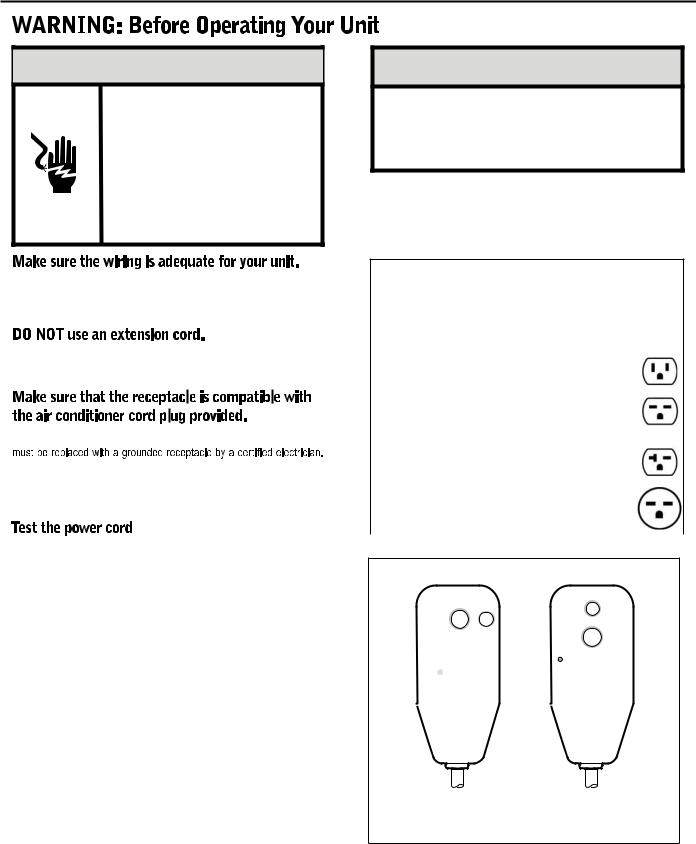
 WARNING
WARNING
Electrical Shock Hazard
Make sure your electrical receptacle has the same configuration as your air conditioner’s plug. If different, consult a Licensed Electrician.
Do not use plug adapters.
Do not use an extension cord. Do not remove ground prong.
Always plug into a grounded 3 prong oulet. Failure to follow these instructions can result in death, fire, or electrical shock.
If you have fuses, they should be of the time delay type. Before you install or relocate this unit, be sure that the amperage rating of the circuit breaker or time delay fuse does not exceed the amp rating listed in Table 1.
The cord provided will carry the proper amount of electrical power to the unit; an extension cord may not.
Proper grounding must be maintained at all times. Two prong receptacles
The grounded receptacle should meet all national and local codes and ordinances. You must use the three prong plug furnished with the air conditioner. Under no circumstances should you remove the ground prong from the plug.
All Friedrich room air conditioners are shipped from the factory with a Leakage Current Detection Interrupter (LCDI) equipped power cord. The LCDI device on the end of the cord meets the UL and NEC requirements for cord connected air conditioners.
To test your power supply cord:
1.Plug power supply cord into a grounded 3 prong outlet.
2.Press RESET (See Figure 1).
3.Press TEST, listen for click; the RESET button trips and pops out.
4.Press and release RESET (Listen for click; RESET button latches and remains in). The power cord is ready for use.
Note: in case of power failure, unit will resume operation according to the last input settings.
NOTICE
Do not use the LCDI device as an ON/OFF switch.
Failure to adhere to this precaution may cause premature equipment malfunction.
Once plugged in, the unit will operate normally without the need to reset the LCDI device. If the LCDI device fails to trip when tested or if the power supply cord is damaged, it must be replaced with a new power supply cord from the manufacturer. Contact our Technical Assistance Line at (800) 541-6645. To expedite service, please have your model number available.
Table 1.
|
CIRCUIT RATING |
REQUIRED |
||
|
OR TIME DELAY |
WALL |
||
MODEL |
FUSE |
RECEPTACLE |
||
|
AMP |
VOLT |
NEMA |
|
|
NO. |
|
||
|
|
|
|
|
SS08N10, SS10N10, |
|
|
|
|
SS12N10, SS14N10, |
15 |
125 |
5-15R |
|
SM15N10,YS10M10 |
|
|
|
|
SS12N30, SS15N30, |
15 |
250 |
6-15R |
|
SM18N30, SM21N30 |
|
|||
SL22N30 |
|
|
|
|
SL24N30, SL28N30, |
|
|
|
|
ES12N33, ES15N33, |
20 |
250 |
6-20R |
|
YS12N33 |
|
|
|
|
|
|
|
|
|
SL36N30, EM18N34, |
|
|
|
|
EL36N35, EM24N34, |
30 |
250 |
6-30R |
|
YM18N34, YL24N35 |
|
|
|
|
|
|
|
|
|
Figure 1
RESET TEST
WARNING
TEST BEFORE EACH USE
1.PRESS RESET BUTTON
2.PLUG LCDI INTO POWER RECEPTACLE
3.PRESS TEST BUTTON, RESET BUTTON SHOULD
 POP UP
POP UP
4.PRESS TEST BUTTON, FOR USE
DO NOT USE IF ABOVE TEST
FAILS
WHEN GREEN LIGHT IS ON
IT IS WORKING PROPERLY
TEST
RESET
WARNING
TEST BEFORE EACH USE
1.PRESS RESET BUTTON
2.PLUG LCDI INTO POWER RECEPTACLE
3.PRESS TEST BUTTON, RESET BUTTON SHOULD POP UP
4.PRESS TEST BUTTON, FOR USE
DO NOT USE IF ABOVE TEST FAILS
WHEN GREEN LIGHT IS ON IT IS WORKING PROPERLY
15/20A LCDI Device |
30A LCDI Device |
FRR001
10
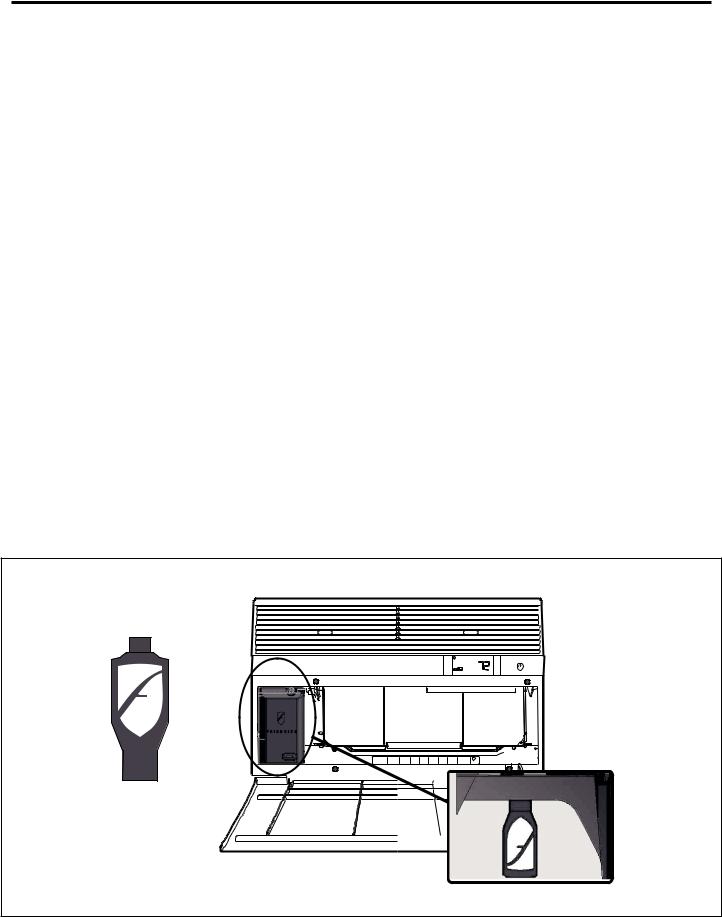
Kuhl Control Options
The Kühl gives you a variety of options for control, programming, and scheduling including wireless capabilities
Wireless Programming and Control:
The new FriedrichLink™ Adapter (sold seperately) allows you to conviently control, program and monitor your air conditioning unit remotely from a smartphone or computer.
FriedrichLink™ Adapter accessory available through Friedrich authorized retailers or www.friedrich.com. See FriedrichLink™ Adapter section on www.friedrich.com for complete details.
Pre-Programmed Scheduling Options:
Your unit’s digital control comes equipped with a 24-hour timer and two preprogrammed 7-day energy management options.
24-Hour Timer
The 24-hour timer allows you to turn the unit off and on at pre-set times by setting an on and off time on the unit control panel. (See page 11 for details on timer set-up.)
Pre-programmed Energy Management
Your unit comes from the factory with two (2) Pre-programmed Energy Management settings are shown in Addendum 1 (Residential & Commercial Schedule Table).
Energy Management Schedule Options are:
1.Residential Schedule – 40 Hr. Work Week
2.Commercial Schedule – 7-Day Business Week
The “Residential” (40 Hr. Work Week) Schedule has four (4) time periods: 06:00, 08:00, 18:00, and 22:00. This option will cause your Kühl Q unit to raise the room temperature temporarily to 85°F during the hours when most people are away at work, lower them again to 78°F prior to the time when most people will return home, and then raise slightly to 82°F to maintain a comfortable temperature overnight.
The “Commercial” (7-Day Business Week) Schedule has two (2) time periods: 07:00 and 18:00. This option will cause your air conditioner to raise temperatures to 84°F after typical working hours and on weekends when commercial spaces are typically unoccupied.
(See Control Panel Operation Instructions Section)
Customizable Programming Options:
Customizable schedules, with up to four temperature adjustments per day, can either be uploaded to the unit via the air conditioner’s built-in micro USB interface or conveniently transmitted wirelessly using the new FriedrichLink™ Adapter accessory, greatly simplifying the programming of one or multiple units.
See Figure 2.
See www.friedrich.com for complete Customizable Programming instructions.
Smart Grid
The Kuhl Unit is also able to be controlled by a Smart Grid.
Smart Grid is a network that brings electricity from power stations to consumers using new technologies that allow power companies to adjust electrical loads of residential users. Check with your local electric company to learn more about Smart Grid programs in your area.
Figure 2
UL |
FriedrichLink™ Adapter
11
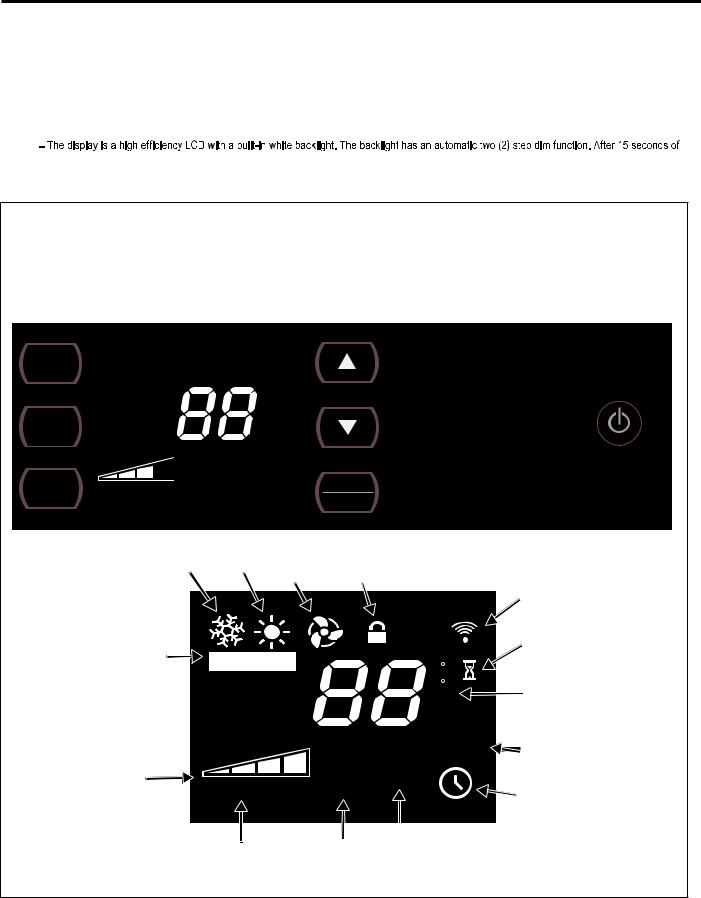
Control Panel and Display Identification
Let’s check out how to control your air conditioner. On the control panel, just above the POWER , is a liquid crystal display (LCD). All of the control panel function buttons and mode icons can be viewed in Figure 3.
Power On – Press the button to turn on the air conditioner. The power button illuminates to indicate that the power is on. The backlight on the power switch will automatically dim to 20% intensity after 15 seconds of inactivity. The remote control can also be used to turn power ON / OFF (See Remote Control).
Display
inactivity, the display dims to 20% intensity. After an additional 120 seconds, the display switches off. Touching any button automatically changes the display to full brightness.
There are three control push buttons on each side of the display.
Figure 3 |
|
SYSTEM |
FAN MODE |
Cycles between |
Sets fan to either: |
AUTO, HEAT, |
- Cycle automatically |
COOL, or FAN |
- Run continuously |
ONLY |
|
(if equipped) |
|
FAN SPEED |
TEMPERATURE |
TIMER / SCHEDULE |
|
Sets fan speed: |
Increment UP |
Turns ON or OFF |
|
LOW, MED, |
TEMPERATURE: |
IR WINDOW: |
ON / OFF |
HIGH or AUTO |
|||
(if equipped) |
Increment DOWN |
Do not block |
Turns unit on/off |
|
|
|
 F
F
SET POINT
AUTO SPEED
COOL HEAT FAN |
CONTROL |
|
|
|
|
ONLY |
LOCKED |
|
|
|
|
|
|
|
|
WI-FI |
|
|
|
|
|
OPERATING |
|
|
|
|
|
(if equipped) |
|
AUTO |
|
|
|
WAIT |
|
Automatically switches |
|
|
|
||
|
|
|
(3 minutes compressor time delay) |
||
between cool & heat |
|
|
|
||
|
F |
|
2 DIGIT DISPLAY |
||
AUTO FAN |
|
|
|||
|
C |
|
Shows Setting for: |
||
CONTINUOUS |
|
AM |
|
|
- Set Point (Temperature) |
|
|
PM |
|
- Room Temperature |
|
|
|
ON OFF |
|
- Clock (AM/PM) |
|
|
SET POINT |
|
|
||
|
SCHEDULE |
|
SCHEDULE ON |
||
|
ROOM TEMP |
|
|
|
|
FAN SPEED
Manually selected AUTO SPEED fan speed
AUTO SPEED
Automatically selects best fan cooling or
heating speed
CHECK $MART |
||
FILTER |
|
TIMER ON |
|
||
FILTER |
|
MART OPERATING |
$ |
||
Check / Clean |
(if equipped) |
|
12

Control Panel Operation Instructions
SYSTEM - The SYSTEM button allows you to sequentially select the modes of operation. To select, press once and let go.
AUTO MODE |
Automatically changes between HEAT and COOL |
|
|
(HEAT and COOL ONLY Units) |
|
COOL MODE |
HEAT MODE |
Not available on some models |
FAN ONLY MODE |
|
|
|
AUTO MODE COOL |
|
|
- AUTO - |
F |
|
|
|
|
AUTO FAN |
|
|
SET POINT |
|
|
COOL ONLY MODE |
FRR204 |
|
|
|
|
|
F |
|
AUTO FAN |
|
|
SET POINT |
|
|
HEAT MODE |
FRR103 |
|
|
|
|
|
F |
|
AUTO FAN |
|
|
SET POINT |
|
|
FAN ONLY MODE |
FRR104 |
|
|
|
FRR105
When in the SYSTEM COOL  or HEAT
or HEAT 
 or FAN ONLY
or FAN ONLY  mode, you can also select FAN MODE, FAN SPEED, TIMER SCHEDULE,
mode, you can also select FAN MODE, FAN SPEED, TIMER SCHEDULE,  and
and
 . The SYSTEM MODE does not change.
. The SYSTEM MODE does not change.
FAN MODE – The  button allows you to select between AUTO FAN and CONTINUOUS modes. To select, press once and let go.
button allows you to select between AUTO FAN and CONTINUOUS modes. To select, press once and let go.
F
AUTO FAN
SET POINT
FRR112
When in the AUTO FAN mode, the fan operates only when the system has a demand to cool or heat the room. Note: the fan is off (no fan speed icon), indicating no command for cooling or heating.
AUTO FAN (Cooling Demand)
F
AUTO FAN
SET POINT
FRR106
System has a demand for cooling. The fan is operating at a medium speed.
CONTINUOUS
F
CONTINUOU
SET POINT
FRR113
In the CONTINUOUS fan mode, the fan operates all the time. The system periodically cools or heats the fan's airflow but the flow of air does not stop.
FAN SPEED - Cooling only units have 4 fan speeds, except models SL28 and SL36. All Cool+Heat units only have 3 fans speeds.
FAN SPEED - The FAN button allows you to toggle between four speeds: LOW, MEDIUM, HIGH, MAX and AUTO speed operation. Press once and let go each time.
SPEED
4 Speed |
AUTO |
FRR095 |
During the (SYSTEM mode COOL or HEAT), the fan speed automatically varies depending on the difference between the unit's set point on the control panel and the actual room temperature. Let me explain. Say for example, you’re working in your garage and you open the big door for several minutes. The system will sense a wide difference between the set point and the actual room temperature. When this occurs, the system fan speed increases to HIGH for a period of time. The fan speed decreases, in step, as the temperature difference decreases. When the room temperature matches the system's set point, fan speed returns to the lowest setting, and if the fan mode is on AUTO FAN, the fan will stop.
13
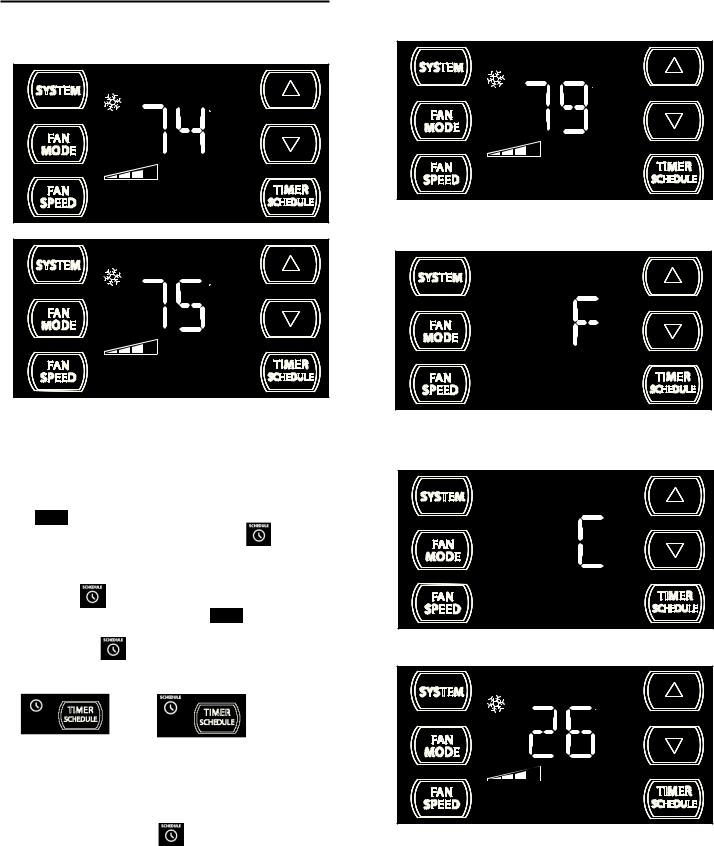
UP  and DOWN
and DOWN  - arrows - Pressing either
- arrows - Pressing either  or
or  button changes the system's set point (desired room temperature). These buttons are also used for setting the Timer and other programming.
button changes the system's set point (desired room temperature). These buttons are also used for setting the Timer and other programming.
F
AUTO FAN
SET POINT
FRR100
F
AUTO FAN
SET POINT
FRR101
One press equals 1 degree of change. Holding the button down for more than 0.6 seconds starts the fast increment/decrement change of the set point.
TIMER SCHEDULE BUTTON -
TIMER |
|
|
|
|
|
|
|
|
The SCHEDULE button has two main uses: |
|
|
|
|||||
1.Used to preselect a TIMER |
|
|
or SCHEDULE |
function. (For |
||||
|
|
|||||||
pre-selection instructions, please see page 17.) |
|
|
|
|||||
2. Used to turn on or activate the pre-selected TIMER |
|
or |
|
|
||||
|
|
|
||||||
SCHEDULE |
. |
|
|
TIMER |
|
|
|
|
|
|
|
|
|
|
|
||
3. To turn on your pre-selction, press the SCHEDULE button once and let |
||||||||
go. The display at bottom right will show the TIMER |
icon |
|
or |
|||||
|
||||||||
SCHEDULE icon |
. |
|
|
|
|
|
|
|
Example: |
|
|
|
|
|
|
|
|
TIMER is turned ON |
SCHEDULE is turned ON |
|
|
|
||||
TIMER (FACTORY DEFAULT) - The TIMER  is the default on new units. The TIMER
is the default on new units. The TIMER  function allows you to turn the unit one time ON and one time OFF daily at the times that you select. For example, you can command the system to turn ON at 8:15 am and to turn OFF at 1:30 pm everyday. (To set the timer, see page 18.)
function allows you to turn the unit one time ON and one time OFF daily at the times that you select. For example, you can command the system to turn ON at 8:15 am and to turn OFF at 1:30 pm everyday. (To set the timer, see page 18.)
SCHEDULE- The SCHEDULE has two options with factory pre-programmed energy management settings: temperature, system and time settings (see addendum) (for more information, see page 17).
Schedule options are:
1. Residential Schedule - 40 hour work week
2. Commercial Schedule - 5 day business week
(These factory pre-programmed settings can only be changed by using the WiFi FriedrichLink™ adaptor, or with an upload via the mirco USB
port, with which you can create your own custom program. See page 11.)
14
ºF - ºC Select
F
AUTO FAN
SET POINT
FRR132
To switch from degrees Fahrenheit (F) to Celsius (C), press  and
and  buttons simultaneously for three seconds.
buttons simultaneously for three seconds.
FRR133
An “F” will flash for 5 seconds and then revert to a normal display. To change from F to C, press the  or
or  button within 5 seconds.
button within 5 seconds.
FRR134
A “C” will flash for 5 seconds and then revert to a normal display.
C
AUTO FAN
SET POINT
FRR135
The ºF icon goes away and the ºC icon illuminates on the normal display.
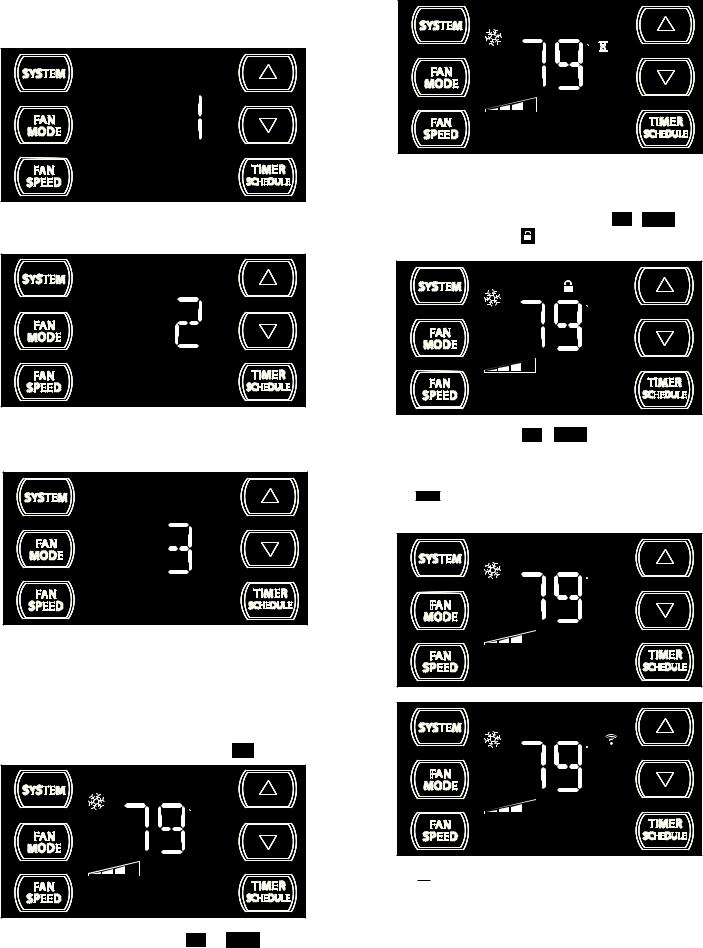
DIM Function
There are three separate display brightness levels, AUTO, 20% and full (100%). To change the DIM setting, press the Power button for three seconds.
FRR192
The 1 indicates a DIM setting of Auto (factory default on new units). Use the  or
or  buttons to change the setting.
buttons to change the setting.
FRR193
The 2 indicates a DIM setting of 20%. Press the TIMER SET button within 15 seconds to save the setting. Button inactivity for more than 15 seconds causes the display to time out and return to the normal operating display.
FRR194
The 3 indicates a DIM setting of 100% (full brightness). Press the TIMER SET (Refer to Figure 8) button within 15 seconds to save the setting. Button inactivity for more than 15 seconds causes the display to time out and return to the normal operating display.
Alerts
Check Filter
When the filter needs to be cleaned or replaced, the CHECKFILTER icon displays.
F
AUTO FAN
SET POINT
CHECK
FILTER
|
|
FRR118 |
The alert can be dismissed by pressing the |
FAN |
TIMER |
MODE and SCHEDULE for 3 seconds. |
||
Wait Icon
F
AUTO FAN
SET POINT
FRR120
The wait icon  illuminates when the compressor lockout is active.
illuminates when the compressor lockout is active.
Control Panel Lock
To lock the front panel controls, press and hold the SPEED + |
SCHEDULE buttons |
|
|
FAN |
TIMER |
for 3 seconds. The lock icon |
illuminates to indicate the locked status. |
|
During lockout, none of the control panel buttons will operate.
F
AUTO FAN
SET POINT
To unlock, press and hold the SPEED + |
FRR116 |
SCHEDULE buttons simultaneously for 3 |
|
FAN |
TIMER |
seconds. |
|
External Control Status
The $MART icon illuminates to indicate that the system is being controlled
remotely, such as from a smart grid from a power company (for more information, see page 10).
SMART
F
AUTO FAN
SET POINT
$MART
FRR125
WiFi Connection
F
AUTO FAN
SET POINT
FRR126
The 
 icon illuminates to indicate that the system is receiving a Wi-Fi connection (for more information, see page 10).
icon illuminates to indicate that the system is receiving a Wi-Fi connection (for more information, see page 10).
15
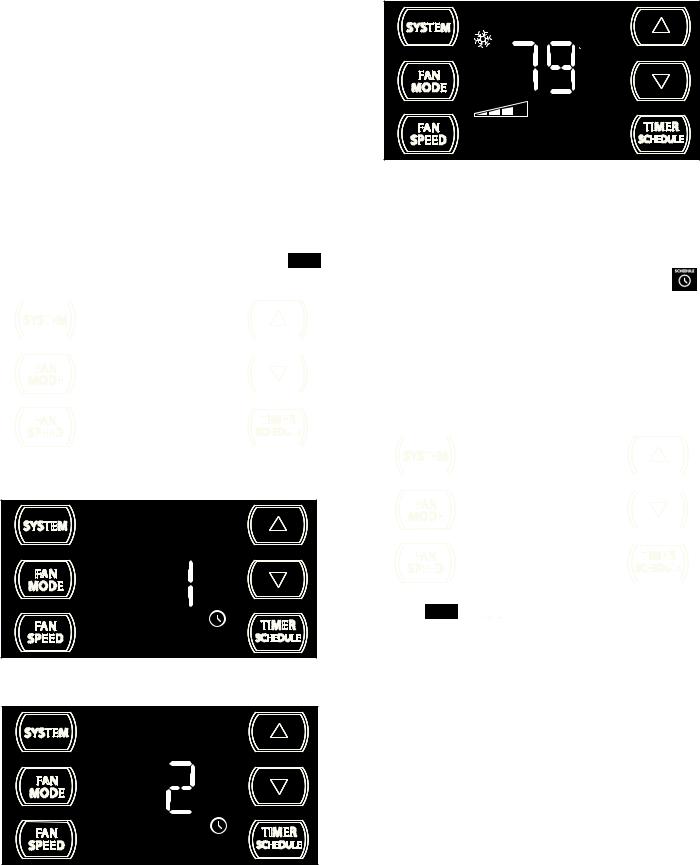
TIMER OR SCHEDULE OPTIONS 1 OR 2 SELECTION
The control system has one Timer and two Schedule functions:
A.Timer (factory default) - Allows you to command the unit to turn ON and OFF at a time you program. Setting the start, stop and day can be found latter in this manual on page 18.
B.Residential Schedule - When selection #1 is selected, the unit follows a pre-programmed set of operational parameters that covers 5 days of the week with 4 time windows during each day. Each time window has it's own set of 8 operating parameters. Refer to Addendum 1.
C.Commercial Schedule - When selection #2 is selected, the unit follows a pre-programmed set of operational parameters that covers 7 days of the week with 2 time windows during each day. Each time window has it's own set of 8 operating parameters. Refer to Addendum 1.
To change the TIMER/SCHEDULE selection, press and hold the |
|
|
TIMER |
||||||||
|
SCHEDULE |
||||||||||
button for 3 sec, then let go. |
|
|
|
|
|
|
|||||
|
|
|
|
|
|
|
|
|
|
|
|
|
|
|
|
|
|
|
|
|
|
|
|
|
|
|
|
|
|
|
|
|
|
|
|
|
|
|
|
|
|
|
|
|
|
|
|
|
|
|
|
|
|
|
|
|
|
|
|
|
|
|
|
|
|
|
|
|
|
|
|
|
|
|
|
|
|
|
|
|
|
|
|
|
|
|
|
|
|
|
|
|
|
|
|
|
|
|
|
|
|
|
|
|
|
|
|
|
|
|
|
|
|
|
|
|
|
|
|
|
|
|
|
|
|
|
|
|
|
|
|
|
|
|
|
|
|
|
|
|
|
|
|
|
|
|
|
|
|
|
|
|
|
|
|
|
|
|
|
|
|
|
|
|
|
|
|
|
|
|
|
|
|
|
|
|
|
|
|
|
|
|
|
|
|
|
|
|
|
|
|
|
|
|
|
|
|
|
|
|
|
|
|
|
|
|
|
|
|
|
|
|
|
|
|
|
|
|
|
|
|
|
|
|
|
|
|
|
|
|
|
|
|
|
|
|
|
|
|
|
|
|
|
|
|
|
|
|
|
|
|
|
|
|
|
|
|
|
|
|
|
|
|
|
|
|
|
|
|
|
|
|
|
|
|
|
|
|
|
|
|
|
|
|
|
|
|
FRR139
The display shows the TIMER is selected. Press the  button once and let go.
button once and let go.
SCHEDULE
FRR137
The display shows option 1 (Residential Schedule) is selected. Press the  button once and let go.
button once and let go.
SCHEDULE
FRR138
The display shows option 2 (Commercial Schedule) is selected.
To save and exit selection, press the TIMER SET button (Figure 4, Page 18).
F
AUTO FAN
SET POINT
FRR136
The display reverts to the normal display.
NOTE: The schedule options 1 and 2 have factory pre-programmed settings which can only be changed by using the WiFi FriedrichLink™ adaptor (an accessory). With it, you can create your own custom schedule program. See page 10 for more information.
NOTE: Once you have selected the TIMER  or SCHEDULE we must first set the following before turning it on.
or SCHEDULE we must first set the following before turning it on.
1.Set time and day
2.Set start time
3.Set stop time
See timer settings on next page.
To Turn On the Timer or Schedule Selected
|
|
|
|
|
|
|
|
|
|
|
|
|
|
|
|
|
|
|
|
|
|
|
|
|
|
|
|
|
|
|
|
|
|
|
|
|
|
|
|
|
|
|
|
|
|
|
|
|
|
|
|
|
|
|
|
|
|
|
|
|
|
|
|
|
|
|
|
|
|
|
|
|
|
|
|
|
|
|
|
|
|
|
|
|
|
|
|
|
|
|
|
|
|
|
|
|
|
|
|
|
|
|
|
|
|
|
|
|
|
|
|
|
|
|
|
|
|
|
|
|
|
|
|
|
|
|
|
|
|
|
|
|
|
|
|
|
|
|
|
|
|
|
|
|
|
|
|
|
|
|
|
|
|
|
|
|
|
|
|
|
|
|
|
|
|
|
|
|
|
|
|
|
|
|
|
|
|
|
|
|
|
|
|
|
|
|
|
|
|
|
|
|
|
|
|
|
|
|
|
|
|
|
|
|
|
|
|
|
|
|
|
|
|
|
|
|
|
|
|
|
|
|
|
|
|
|
|
|
|
|
|
|
|
|
|
|
|
|
|
|
|
|
|
|
|
|
|
|
|
|
|
|
|
|
|
|
|
|
|
|
|
|
|
|
|
|
|
|
|
|
|
|
|
|
|
|
|
|
|
|
|
|
|
|
|
|
|
|
|
|
|
|
|
|
|
|
|
|
|
|
|
|
|
|
|
|
|
|
|
|
|
|
|
|
|
|
|
|
|
|
|
|
|
|
|
|
|
|
|
|
|
|
|
|
|
|
|
|
|
|
|
|
|
|
|
|
|
|
|
|
|
|
|
|
|
|
|
|
|
|
|
|
|
|
|
|
|
Press the |
|
SCHEDULE |
|
|
|
|
FRR139 |
||||||||
|
button and let go. The system will operate in the mode |
||||||||||||||
|
|
|
|
|
TIMER |
|
|
|
|
|
|
|
|
||
option (1, 2 or Timer) you selected. At the above image, TIMER is selected and turned on.
16
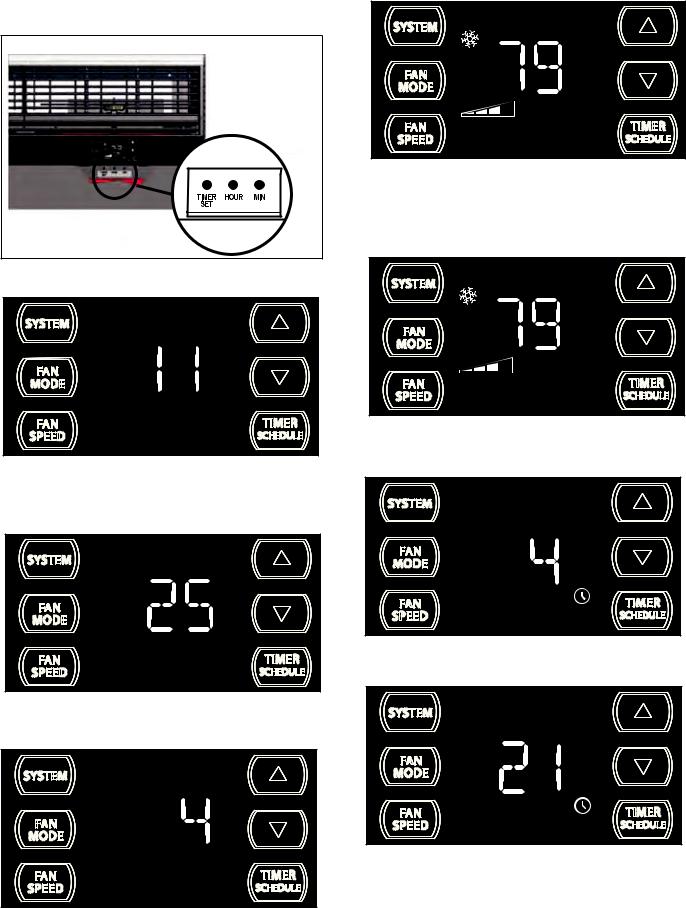
TIMER SETTINGS
1. Set time and day 2. Set start time 3. Set stop time
Figure 4
SET TIME AND DAY - To adjust the unit's time press and hold the HOUR and the MIN buttons for three seconds (Refer to Figure 4).
AM
FRR128
The unit's current hour displays. Use the  or
or  buttons to adjust the hour. To change from AM to PM continue to increment (roll) the display. Press TIMER SET (Refer to Figure 4) button to save the hour and display the unit’s current minutes.
buttons to adjust the hour. To change from AM to PM continue to increment (roll) the display. Press TIMER SET (Refer to Figure 4) button to save the hour and display the unit’s current minutes.
FRR129
Use the  or
or  buttons to adjust the minutes. The clock is now set for 11:25 AM. Press TIMER SET (Refer to Figure 4) button to display the unit's day setting.
buttons to adjust the minutes. The clock is now set for 11:25 AM. Press TIMER SET (Refer to Figure 4) button to display the unit's day setting.
FRR130
Use the  or
or  buttons to adjust the day (1 to 7). The day setting is up to the user. If you set the current day = 1. So if today is Tuesday, then Day 1 = Tuesday, select 1.
buttons to adjust the day (1 to 7). The day setting is up to the user. If you set the current day = 1. So if today is Tuesday, then Day 1 = Tuesday, select 1.
 F
F
AUTO FAN
SET POINT
FRR131
Press TIMER SET (Refer to Figure 4) button to exit and save the SET TIME function. The TIMER SET button must be pressed within 15 second. Button inactivity for more than 15 seconds causes the display to time out and return to the normal operating display.
Timer Start Time
 F
F
AUTO FAN
SET POINT
FRR140
The display shows a normal system. Press and hold the HOUR button (Figure 4) for 3 seconds. Note: The Timer start-stop times may be set even when the system is in the Timer or Schedule mode.
AM
ON
FRR141
Use the  or
or  button to adjust the hour. Press the TIMER SET button (Figure 4) to adjust the minutes.
button to adjust the hour. Press the TIMER SET button (Figure 4) to adjust the minutes.
ON
FRR142
Use the  or
or  button to adjust the minutes. Press the TIMER SET button (Figure 4) within 15 seconds to exit and save the setting. The timer is now set to start at 4:21 AM.
button to adjust the minutes. Press the TIMER SET button (Figure 4) within 15 seconds to exit and save the setting. The timer is now set to start at 4:21 AM.
The display will return to normal.
17
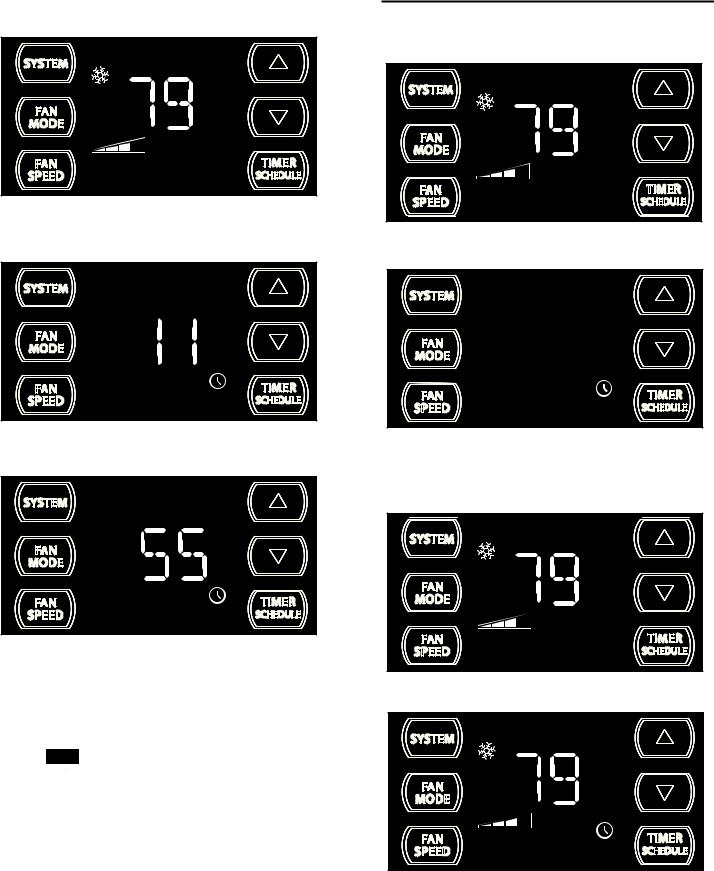
Set theTimer Stop Time
 F
F
AUTO FAN
SET POINT
FRR144
The display shows a normal system. Press and hold the MIN button (Figure 4) for 3 seconds. Note the Timer start - stop times may be set even when the system is in the Schedule mode.
AM
OFF
FRR145
Use the  or
or  button to adjust the hour. Press the TIMER SET button (Figure 4) to advance to the Minutes section.
button to adjust the hour. Press the TIMER SET button (Figure 4) to advance to the Minutes section.
OFF
FRR146
Use the  or
or  button to adjust the minutes. Press the TIMER SET button (Figure 4) within 15 seconds to exit and save the setting. The timer is now set to stop at 11:55 AM. The display returns to normal.
button to adjust the minutes. Press the TIMER SET button (Figure 4) within 15 seconds to exit and save the setting. The timer is now set to stop at 11:55 AM. The display returns to normal.
Turning the TIMER ON once the time and day, the start and top times have been set:
Press the |
TIMER |
button once and let go. |
SCHEDULE |
NOTE: See the following TIMER  ON/OFF scenarios.
ON/OFF scenarios.
Timer ON Scenarios
Scenario 1
 F
F
AUTO FAN
SET POINT
FRR156
The display shows a normal operating system.
FRR157
If the Timer function is turned ON during the Timer’s OFF time, the  icon illuminates. The control system immediately turns the unit OFF.
icon illuminates. The control system immediately turns the unit OFF.
Scenario 2
 F
F
AUTO FAN
SET POINT
FRR158
The display shows a normal operating system.
 F
F
AUTO FAN
SET POINT
FRR159
If the Timer function is turned ON during the Timer’s ON time, the  icon illuminates. The control system immediately turns the unit OFF.
icon illuminates. The control system immediately turns the unit OFF.
18
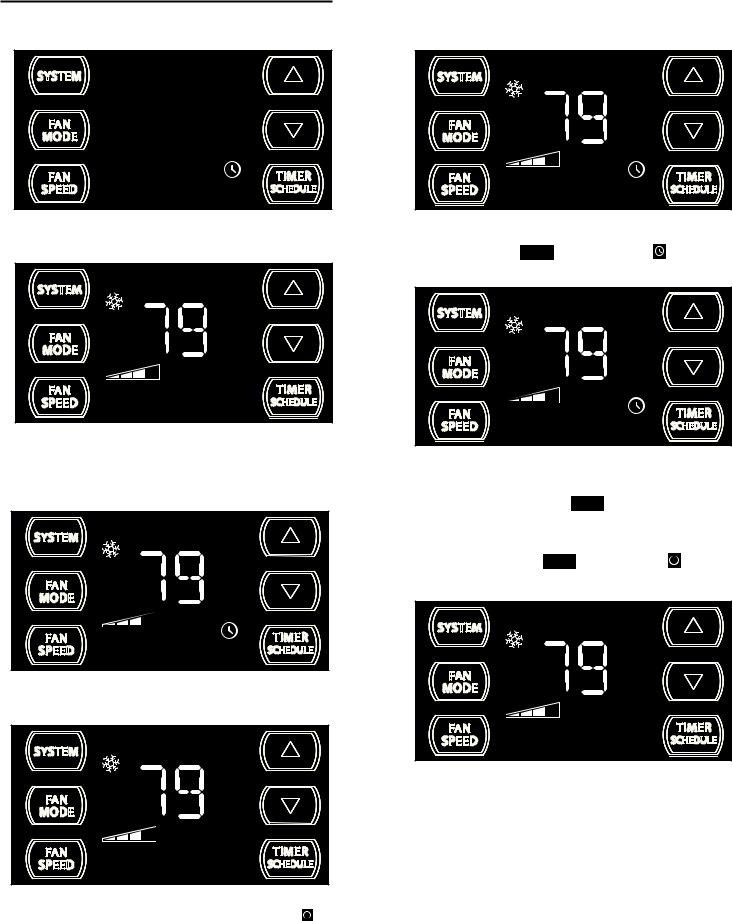
Timer OFF Scenarios
Scenario 1
FRR166
The display shows the unit in Timer mode during an in-active (OFF) period.
 F
F
AUTO FAN
SET POINT
FRR167
If the Timer function is turned OFF during an in-active (OFF) period, the Timer  icon turns off. The display shows a normal system.
icon turns off. The display shows a normal system.
Scenario 2
 F
F
AUTO FAN
SET POINT
FRR168
The display shows the unit in Timer mode during an active (ON) period.
 F
F
AUTO FAN
SET POINT
FRR169
If the Timer function is turned OFF during the ON time. The Timer  icon turns off. The control stays in the current state.
icon turns off. The control stays in the current state.
The display shows a normal system.
Timer - Schedule Control Block
 F
F
AUTO FAN
SET POINT |
SCHEDULE |
|
FRR148
If the unit is operating in the TIMER or SCHEDULE mode, and you press
any bytton except the TIMER button, the TIMER icon begins to
SCHEDULE
blink. All button action is blocked.
 F
F
AUTO FAN
SET POINT |
SCHEDULE |
|
FRR149
The TIMER  icon stops blinking after 3 seconds. You must turn the active TIMER or SCHEDULE mode OFF before making changes. Once
icon stops blinking after 3 seconds. You must turn the active TIMER or SCHEDULE mode OFF before making changes. Once
the changes are made, press the TIMER button to re-activate TIMER
or SCHEDULE mode.
SCHEDULE
If the unit is operating in the TIMER or SCHEDULE mode, and then you
press any button except the TIMER button, the TIMER  icon begins
icon begins
to blink.
SCHEDULE
 F
F
AUTO FAN
SET POINT
FRR150
All button action is blocked.
19
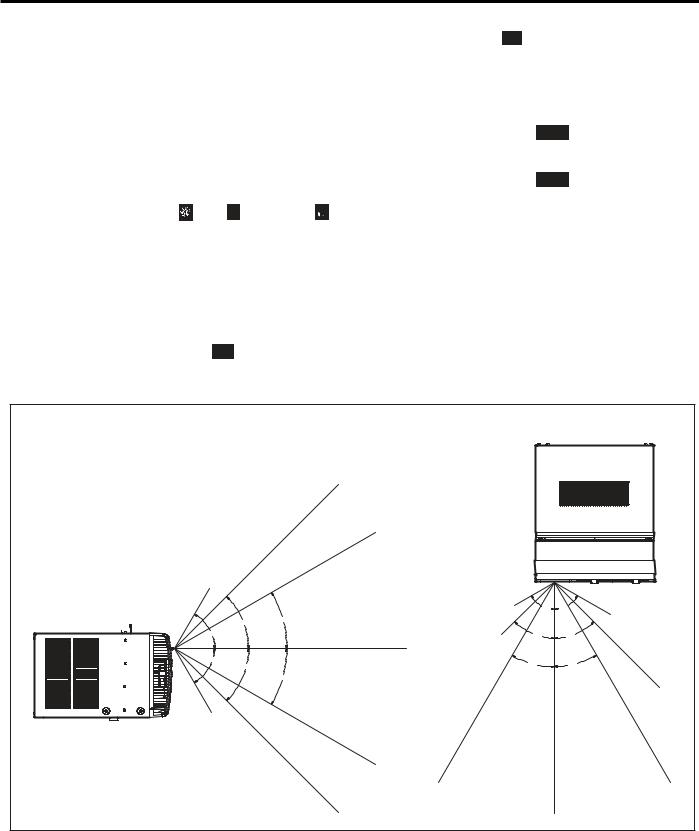
Remote Control Operation
Remote Control - Refer to Figures 12 and 13 during operation description.
Getting Started - Install two (2) AAA batteries in the battery compartment located on the back of the unit.
Operation - The remote control should be within 25 feet of the air conditioner for operation. (Refer to Figure 11 for effectiveness). Press the power button to turn the remote on. The remote will automatically power off after 15 seconds if the buttons are not being pressed. The remote must be on to control the unit.
POWER Button - Turns remote and unit on and off.
SYSTEM Button - Allows the user to sequentially select the following: AUTO - AUTO -, COOL , HEAT 

 , and FAN ONLY
, and FAN ONLY 
 operations. When the button is pressed, the display indicates which mode has been selected via a display message.Note that when the heating function is not available, the system will automatically skip the HEAT mode.
operations. When the button is pressed, the display indicates which mode has been selected via a display message.Note that when the heating function is not available, the system will automatically skip the HEAT mode.
FAN MODE Button - Selects between automatic ( |
|
) or |
|
|
||||||||
AUTO FAN |
CONTINUOUS |
|||||||||||
operation. In the |
|
|
|
mode, the fan only turns on and off when the |
|
|||||||
AUTO FAN |
|
|||||||||||
|
|
|
|
compressor operates or the heat function is enabled. |
||||||||
NOTE: |
|
|
is not available in the FAN ONLY Mode, the display |
|||||||||
AUTO FAN |
||||||||||||
|
indicates |
|
|
. In the |
|
mode, fan speed is |
||||||
|
|
CONTINUOUS |
CONTINUOUS |
|||||||||
determined |
by your |
selection on the SPEEDFA N |
button. |
|||||||||
FAN SPEED Button - Used to sequentially select new fan speed, plus AUTO operation. When the SPEEDFA N button is pressed, the fan speed icon (triangle) changes to indicate the new speed level. Fan speed automatically varies depending on the set temperature on the control panel and the actual room temperature. For example if there is a big difference between your set temperature and the actual room temperature, the system fan speed increases to HIGH. It remains at this speed until the room temperature matches the set temperature.
TIMER/SCHEDULE Button - The |
TIMER |
button turns the schedule |
SCHEDULE |
function on and off. Press the Schedule button once to turn on the Schedule (Residential, Commercial, or Timer) that has already been
selected on your unit. Pressing the TIMER button a second time turns
the schedule function off.
SCHEDULE
UP and DOWN Arrows - Pressing either the  (UP) or
(UP) or  (DOWN) button changes the desired room temperature. The factory preset lower and upper limits are 60°F (16°C) and 99°F (37°C). These buttons are also used to navigate between function options when using the User Menu or Maintenance Mode.
(DOWN) button changes the desired room temperature. The factory preset lower and upper limits are 60°F (16°C) and 99°F (37°C). These buttons are also used to navigate between function options when using the User Menu or Maintenance Mode.
Remote Effectiveness
Hand Held Remote - Has an operating range of up to 25 ft. The infrared remote control signal must have a clear path to transmit the command to the air conditioning unit. The remote signal has some ability to "bounce" off of walls and furniture similar to a television remote control. The diagram below shows the typical operating range of the control in a standard room with 8 ft high ceilings.
Figure 11 |
|
|
|
|
TOP VIEW |
|
|
|
|
|
|
|
|
|
25ft |
|
|
|
|
|
25ft |
|
|
|
7.5ft |
|
|
|
|
SIDE VIEW |
|
|
4ft |
60° |
60° |
|
45° |
30° |
|
6ft |
|
|
|
|
|
||
|
|
|
|
|
|
|
60° |
|
8ft |
45° |
45° |
|
|
|
|||
|
|
|
25ft |
|
|
|
60° |
45° |
|
30° |
30° |
|
|
|
|||
|
|
|
30° |
|
|
|
|
|
|
|
16ft |
|
8ft |
|
|
|
|
|
|
|
25ft |
|
|
|
|
|
25ft |
|
25ft |
|
|
|
25ft |
|
25ft |
|
|
|
|
|
|
|
|
|
|
|
FRR080 |
Changing Temperature from F˚ (Fahrenheit) To C˚ (Celsius) or Reverse
Be within 25' of unit with the remote control. Press the SYSTEM and FAN MODE buttons at the same time and hold for 3 seconds. The display will show the temperature in Celcius. Do the same to reverse temperature to F˚ (Fahrenheit). (The remote control operation overrides manual settings on unit)
20
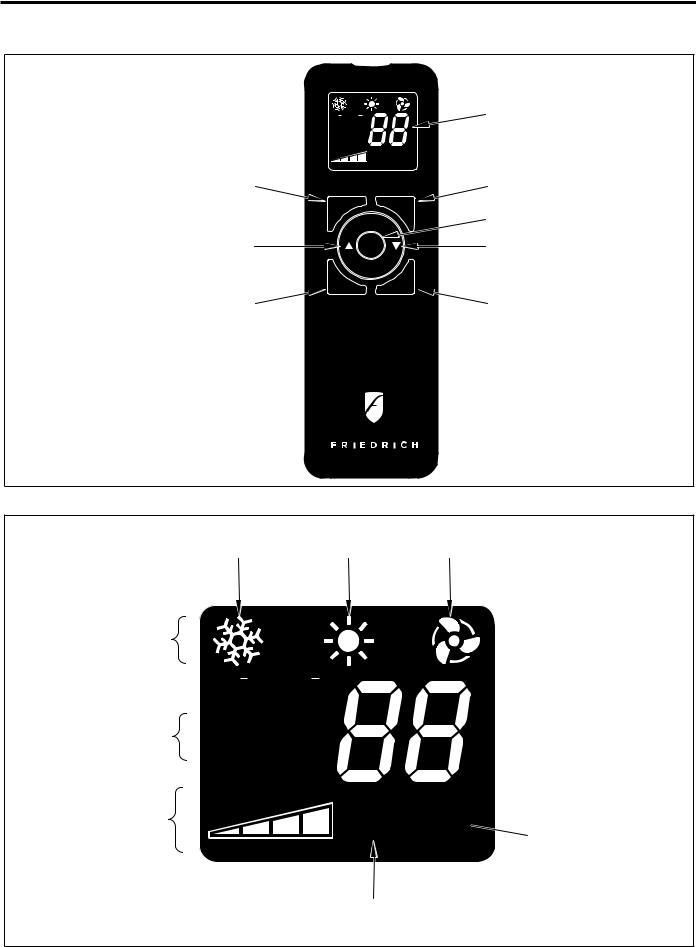
Remote Control Operation (Continued)
Figure 12
SYSTEM
TEMPERATURE UP
FAN SPEED
AUTO
AUTO FAN
CONTINUOUS

 C
C F
F
SYSTEM |
FAN MODE |
POWER
FAN SPEED |
SCHEDULE |
DISPLAY
FAN MODE
POWER
TEMPERATURE DOWN
SCHEDULE
FRR081
Figure 13 |
HEAT |
FAN ONLY |
COOL |
||
ICON |
ICON |
ICON |
SYSTEM
MODE
AUTO
FAN
MODE
FAN
SPEED
AUTO FAN
CONTINUOUS

 C
C F
F
°F / °C ICONs
SCHEDULE
ICON
FRR082
21
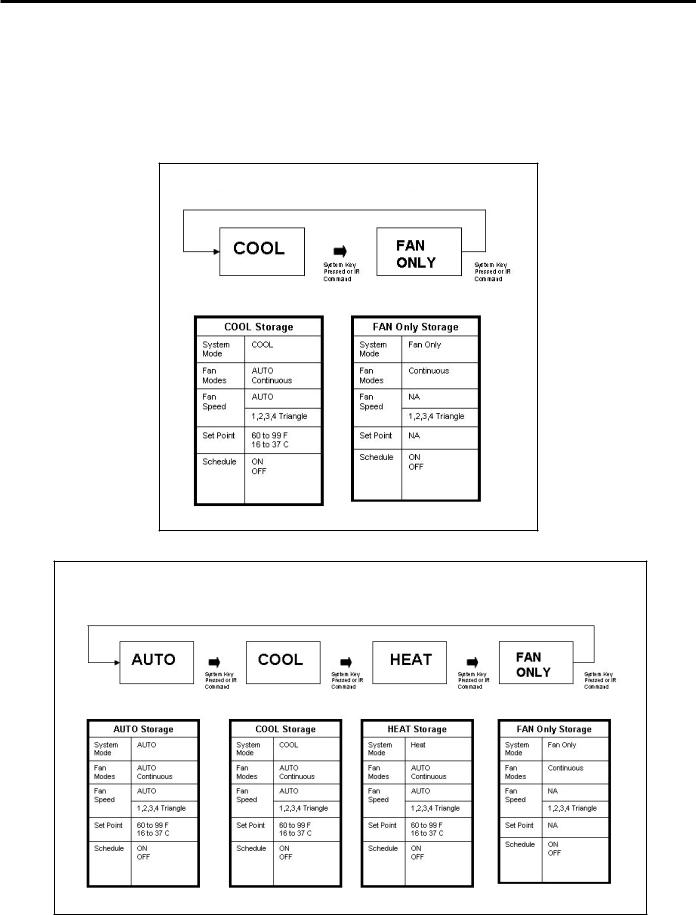
UNIT OPERATION
Front Panel
System Mode Sequence (TIMER/SCHEDULE = OFF)
There are two system modes of operation. One for a cool only unit (see figure 1) and one for a heat-cool unit (see figure 2). System parameters for each system mode are saved when exiting a system mode, and retrieved when entering a new system mode.
Figure 1
System Mode: Cool Only Units
|
|
|
|
Timer/ |
|
Timer/ |
|||
|
|
|
Schedule |
|
|
Schedule |
|
|
|
|
|
|
|
|
|
|
|
|
|
|
|
|
|
|
|
|
|
|
|
Figure 2
System Mode: Heat - Cool Units
|
|
|
|
|
|
Timer/ |
Timer/ |
|
Timer/ |
|
Timer/ |
||
|
|
|
Schedule |
|||
Schedule |
|
Schedule |
|
Schedule |
|
|
|
|
|
|
|||
|
|
|
|
|
|
|
22
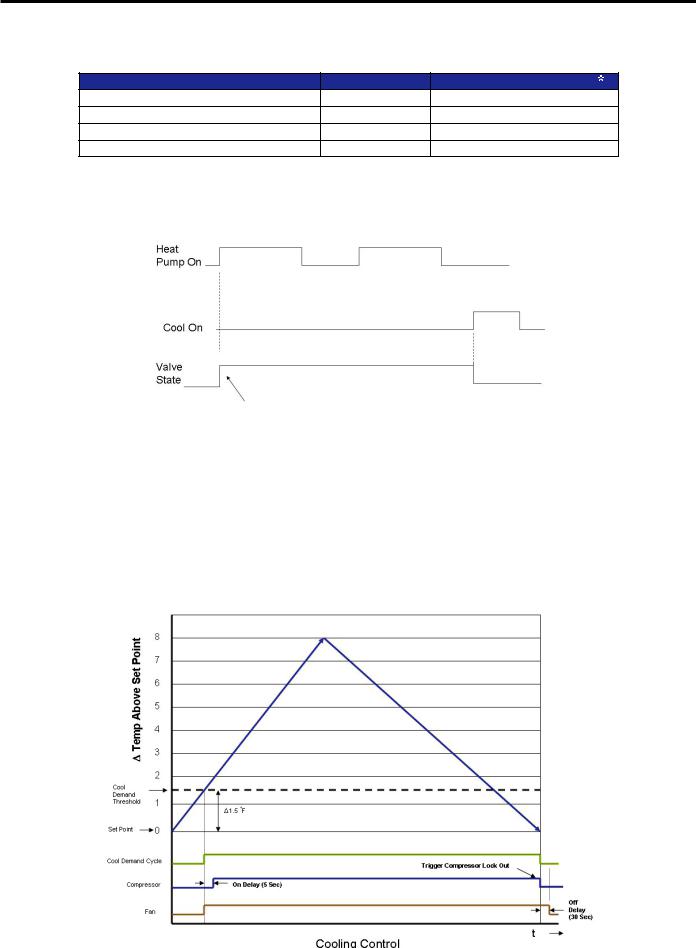
ELECTRONIC CONTROL SEQUENCE OF OPERATION
Compressor and Reversing Valve Control
Active Mode |
Compressor |
Reversing Valve State |
Cooling |
On |
De-Energized |
Heat - Heat Pump |
On |
Energized |
Heat - Electric |
Off |
|
Fan Only |
Off |
|
* The Reversing valve stays in the last state until a call for heat or cooling (see figure below)
Compressor Operation:
The reversing valve only changes when required to provide cooling or heat pump. The RV valve stays in it's last state until required to change.
Cooling Mode
Once the ambient temperature rises past the cool demand threshold (Cool Set Point + 1.5 ˚F) (see figure below), and the compressor is not locked out, the cooling cycle begins. As shown in the figure below, the fan is started 5 seconds prior to the compressor. Once the ambient temperature has been lowered to the cool set point (Cool Set Point minus
.25 ˚F), the cooling cycle starts to terminate by shutting off the compressor. After a 30 seconds delay, the fan is shut off. (See figure below for graphic details)
23
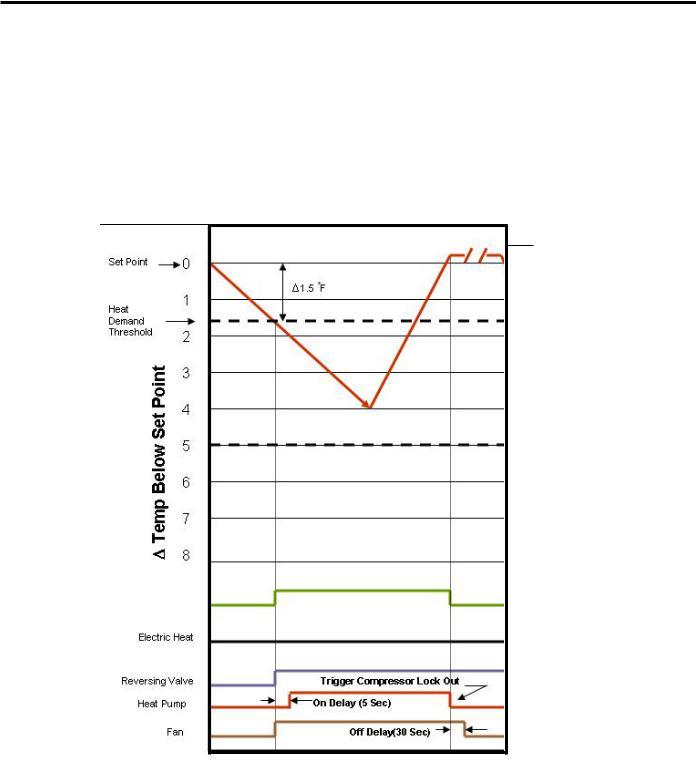
Heating Mode Control Operation
There are two heating methods: Heat Pump and Electric Resistance Heat.
There are 3 types of units that provide heating: Heat Pump Only (Model YS10M10)
Heat Pump with Electric Heat and Cool with Electric Heat.
Heat Control Operation Heat Pump Only Unit (YS10M10 has no electric heat back-up)
Once the ambient temperature falls below the Heating Demand Threshold
(1.5 ˚F Below the Heat Set Point Temperature), the heating cycle begins. The fan is turned on 5 seconds before. Once the ambient temperature has been raised to the Heat Satisfied Point (Set point + .25 ˚F), the compressor is turned off. The fan is turned off 15 seconds later. The figure below illustrates the basic heat pump operation.
Satisfied Point
Heat Control (Heat Pump Only)
YS10M10 Heat Pump Defrost Cycle Operation
The defrost in this unit is an active reverse cycle. The defrost control runs in the background and determines when a defrost cycle is required. Once initiated, the defrost cycle runs to completion.
The defrost cycle can only be initiated when the heat pump is in operation. The compressor will not be turned off to avoid activating the compressor's time delay. The reversing valve will be switched to the cool mode position. The indoor fan/blower will be turned off. Once the defrost cycle is finished, the system should re-enter a heating demand cycle if required.
When the heat pump run time is 60 minutes or greater with an outdoor coil temperature of 26F degrees or lower, the control will run an active defrost for up to 6 minutes. When the temperature at the outdoor coil reaches 54F degrees, the heat pump heat will resume.
24
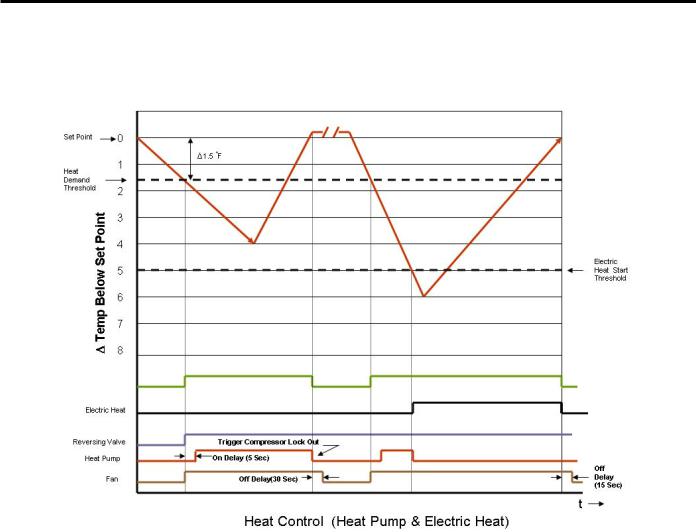
Heat Pump With Electric Heat Operation
This heating is more complex due to the possibility of two heating methods. If the ambient indoor temperature is below the heat demand threshold (1.5˚F below the heat set point temperature), and the compressor is not locked out, turn on compressor. If the ambient indoor temperature is 0.25˚F above the heat set point turn off the compressor.
If the compressor is locked out & electric heat is available:
1.Turn on the electric heat until the compressor is not locked out.
2.After lockout, turn off the electric heat, wait 5 seconds, then turn on the compressor.
If Electric Heat is Available
After the Heat button is initially pressed, the unit will run the electric heater first until the initial set point is satisfied (Hot Start Feature). After the initial start, the unit will switch to Heat Pump heat and decide between Heat Pump heat and Electric heat based on the following two monitored conditions:
Condition 1
If the outdoor coil temperature sensor drops to 30 ˚F or less for 2 consecutive minutes, the unit will switch to electric heat if available. Thereafter, the unit will switch back to Heat Pump heat if the outdoor coil temperature sensor rises to 45 ˚F or greater.
If Electric Heat is not available (out of order) and the outdoor coil temperature sensor drops to 30 ˚F or less for 2 consecutive minutes, then the compressor and fan will turn off. Thereafter, the unit will switch back to Heat Pump heat if the outdoor coil temperature rises to 45 ˚F or greater.
25

Heat Pump With Electric Heat Operation (Continued)
Condition 2
If the (delta) (set point temperature minus the ambient indoor temperature) is greater than 5 ˚F, then the unit will switch to electric heat, if available. The unit will continue to operate with electric heat until the heat demand is satisfied. Note that the electric heat switches on after the temp passes 5°F and the heat pump switches off. Also note that the electric heat will run until the heat demand is satisfied. When another heat demand cycle is initiated, the heat pump will run unless the temp is greater than the electric heat threshold.
Automatic Emergency Heat
If the sealed system fails with a bad reversing valve or anything that causes the indoor coil to get colder than the indoor ambient temperature:
1)If the indoor coil thermistor senses a 5 degree temperature drop as compared to the ambient temperature thermistor and this lasts up to 5 minutes, the control board will switch the unit to electric heat and continue heating with it.
2)At this point, error code 15 is generated; heat pump failure. Indoor coil temperature lower than indoor ambient temperature for 5 or more degrees for 5 consecutive minutes.
Note: It is Ok to continue to use the unit with the electric heater until the heat pump is repaired.
Electric Heat Operation in Cool with Electric Heat Units
When in the Heat mode, with and without Fan Mode Auto (Fan cycling):
If the indoor ambient temperature is below the Heat Demand Threshold (Heat Set Point minus 1.5 ˚F), turn on electric heat. If Ambient is 0.3 ˚F above the Heat Set Point turn off the electric heat.
System Mode Auto
This mode provides automatic change over between cool and heat. The auto mode runs based on the room ambient temperature vs. the Demand Thresholds. It is only available in Heat-Cool Unit.
Notes:
There is a buffer zone between the cool and heat set points where no heating or cooling is allowed to occur. It is critical that the Cool Demand Threshold be greater than the Heat Demand Threshold by a minimum of 3° while in the Auto System Mode. For example, if a user enters a value for the Auto Cooling Set Point that violates the minimum 3° rule, the Auto Heating Set Point will adjust accordingly.
Automatic Change Over Delay (Cool with Heat Units)
The change over delay ensures that any system heating or cooling over shoot does not trigger an opposite demand cycle. The change over delay = 15 min. This timer blocks the opposite demand cycle from running until the timer expires. As an example, if the last demand was a cool cycle, and another cool cycle is requested, the timer will not block the request.
However, if the last demand cycle was a cool cycle, and heat cycle is requested, the timer will block the request until the change over delay is expired.
26
Compressor Lock Out Time
The lockout feature ensures that the compressor is de-energized for a period of time. The timer varies randomly from 180 to 240 seconds
The compressor lockout is initiated every time the compressor is “off” due to:
(1)Satisfying the temperature set point
(2)Changing mode to fan only or heat
(3)Turning the unit off
(4)Control is first plugged in or power is restored after failure
(5)Line power is restored from a brown out condition
Wait ICON (Hour Glass  )
)
The wait icon will be turned on when the compressor is locked out and during demand for cooling or heat pump compressor operation. The Wait ICON will be turned off when the condition clears.
Cooling Fan Delay
Fan cycle/Auto mode only
When unit cycles cooling ON – starts the fan 5 seconds EARLY. When unit cycles cooling OFF – DELAYS the fan off for 30 seconds
Note: this fan delay is disabled during Test Mode
Heating Fan Delay
This is only for fan Mode Auto (Fan cycles with cool/heat operation) and not for continuous fan mode. When unit cycles Heating ON – starts the fan 5 seconds EARLY. When unit cycles Heating OFF – DELAYS the fan off for 15 seconds
Note: the fan delay is disabled during Test Mode
Fan Speed Change Delay
Relay activation is delayed by a minimum number of seconds. The default for this value is 2 seconds and is used to eliminate relay chatter.
Fan Only System Mode
The fan is turned on and runs at the specified manually set speed.
Only the Fan is turned on. Cool or Heat operation are off.
(This is different than FAN MODE CONTINUOUS where the fan is on with the cool or heat operation).
Fan Only Rules
1.If the SYSTEM FAN ONLY MODE is selected, the Auto fan mode is disabled, and the fan mode is forced to continuous. In addition, the auto fan speed is disabled. If the user presses the fan speed key, the menu will skip over the auto selection. The set point temperature display is off.
2.Any fan speed may be manually selected during Fan Only Mode.
27
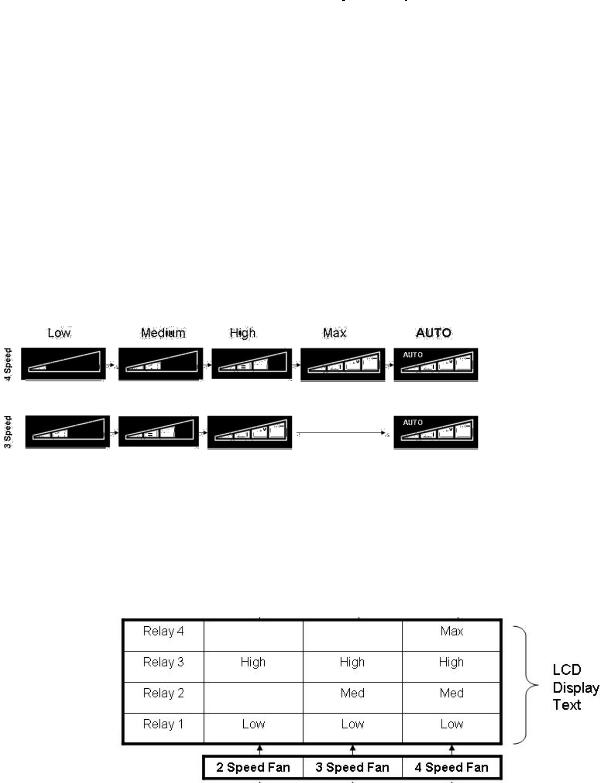
Fan Operation (Front Panel Mode)
Heat – Cool – Auto – Fan Only
Models starting with SS, SM have 4 speeds. Models with SL, and all Kuhl+ have 3 speeds
|
|
|
|
|
|
Speed Selection |
||
|
|
|
|
1 |
2 |
3 |
4 |
AUTO |
|
|
|
|
|
|
|
|
AUTO Operation, but never |
|
|
|
|
|
|
|
|
turns Off. Uses cool set point |
|
Continuous |
|
|
|
|
or heat set point vs. ambient |
||
|
|
|
|
|
||||
|
|
|
|
|
temperature. When there is |
|||
|
|
|
|
|
|
|
|
|
Fan |
|
|
|
"On" " |
On" |
"On" " |
On" |
no demand, operate at the |
|
|
|
lowest available speed. |
|||||
|
|
|
Turns |
Turns |
Turns |
Turns |
|
|
|
|
|
|
|
||||
|
|
|
|
On or |
On or |
On or |
On or |
AUTO operation turns On or |
|
|
|
|
Off with |
Off with |
Off with |
Off with |
Off with heat or cool demand |
|
|
AUTO |
|
|||||
|
|
|
heat or |
heat or |
heat or |
heat or |
Uses cool set point or heat |
|
|
|
|
|
|||||
|
|
|
|
cool |
cool |
cool |
cool |
set point vs. ambient |
|
|
|
|
demand |
demand |
demand |
demand |
temperature |
Mode |
|
Fan Only |
|
"On" " |
On" |
"On" " |
On" |
Disabled |
Table
Fan ICON Detail
The system may have a 3 or 4 speed fan. The Fan Speed ICON will Display as per the table below.
Note that in the AUTO mode, the speed of the fan will be shown by illuminating the number of bars in the speed triangle.
Fan Relay Operation
Front Panel
Using the
28
